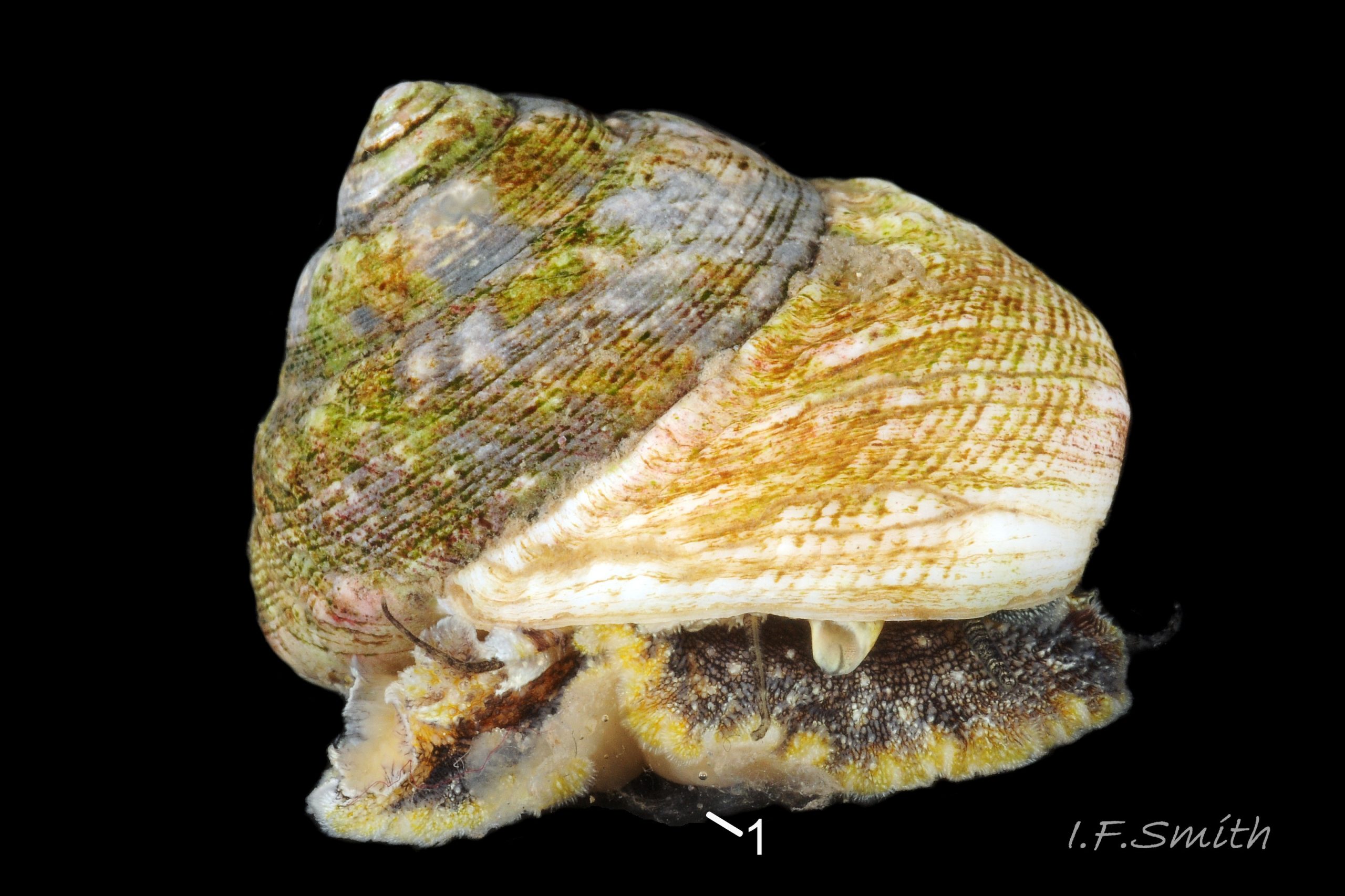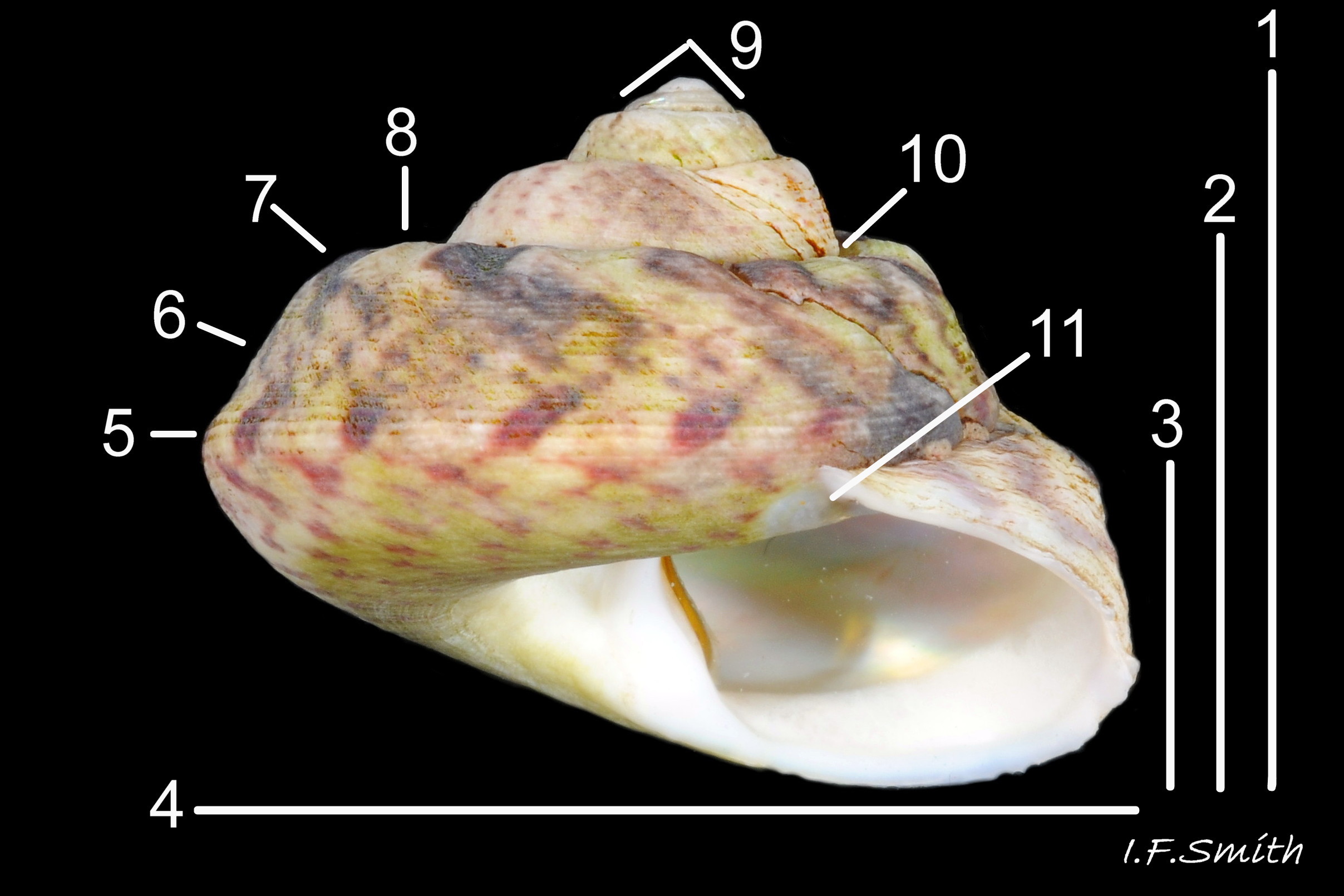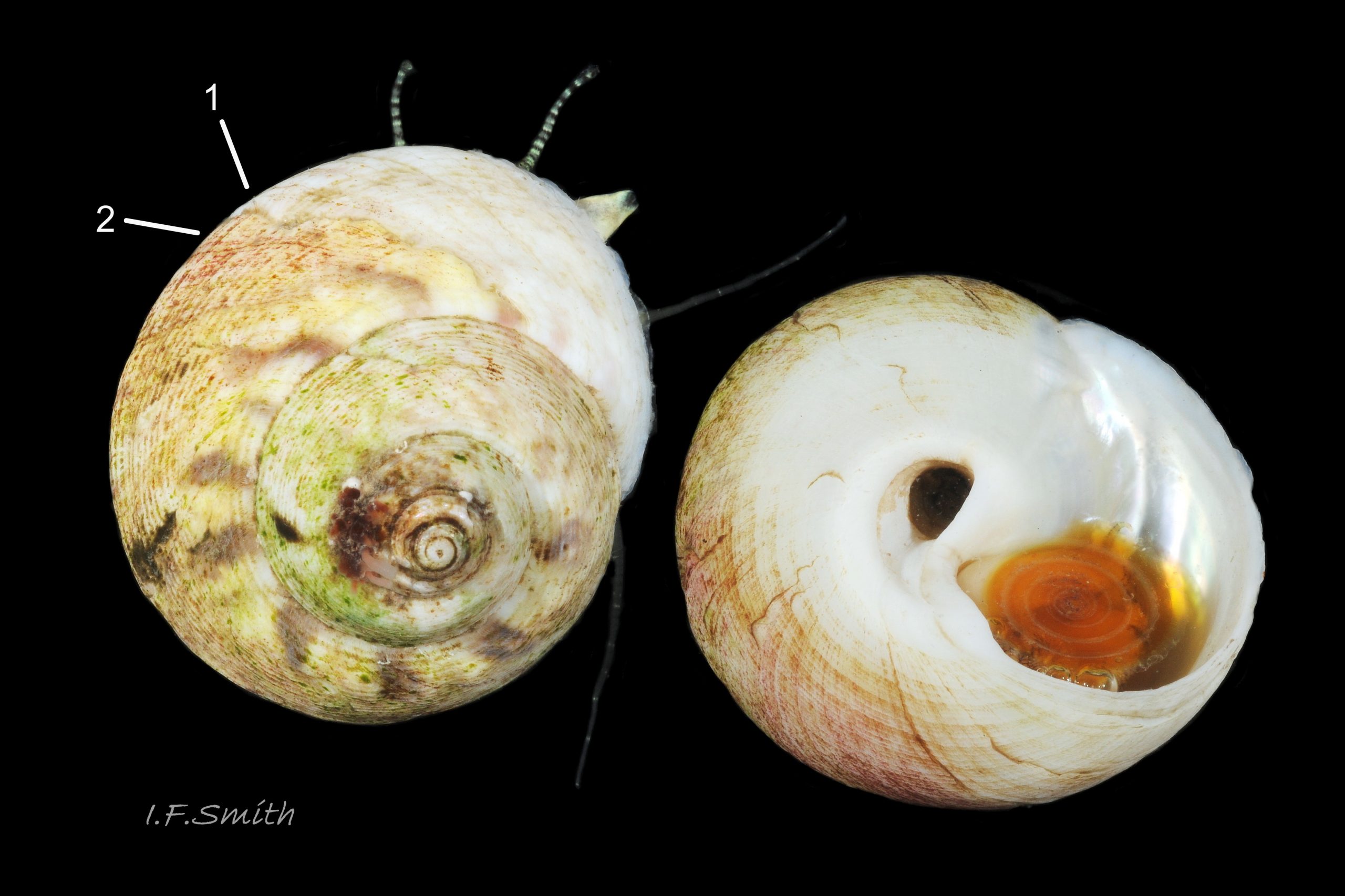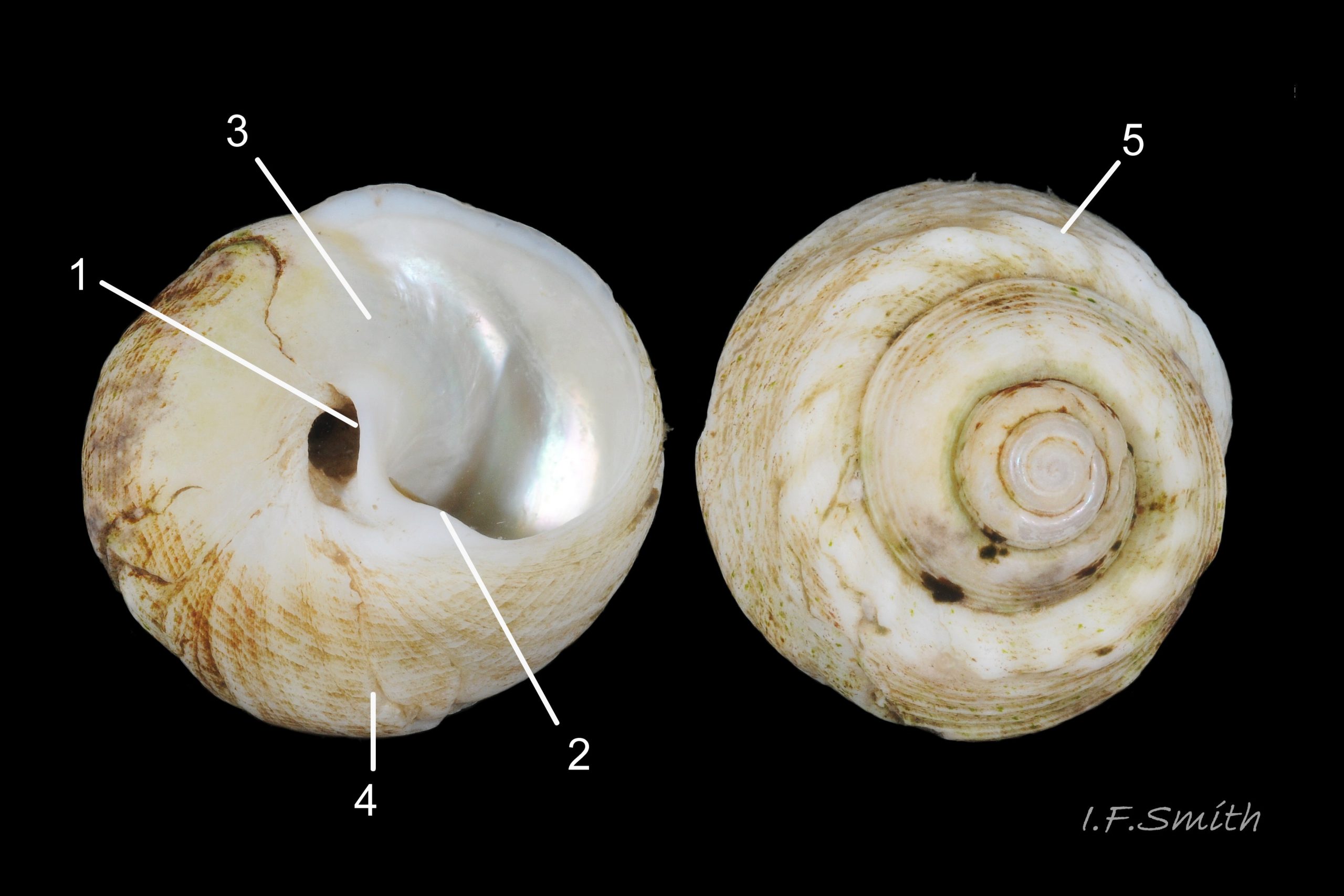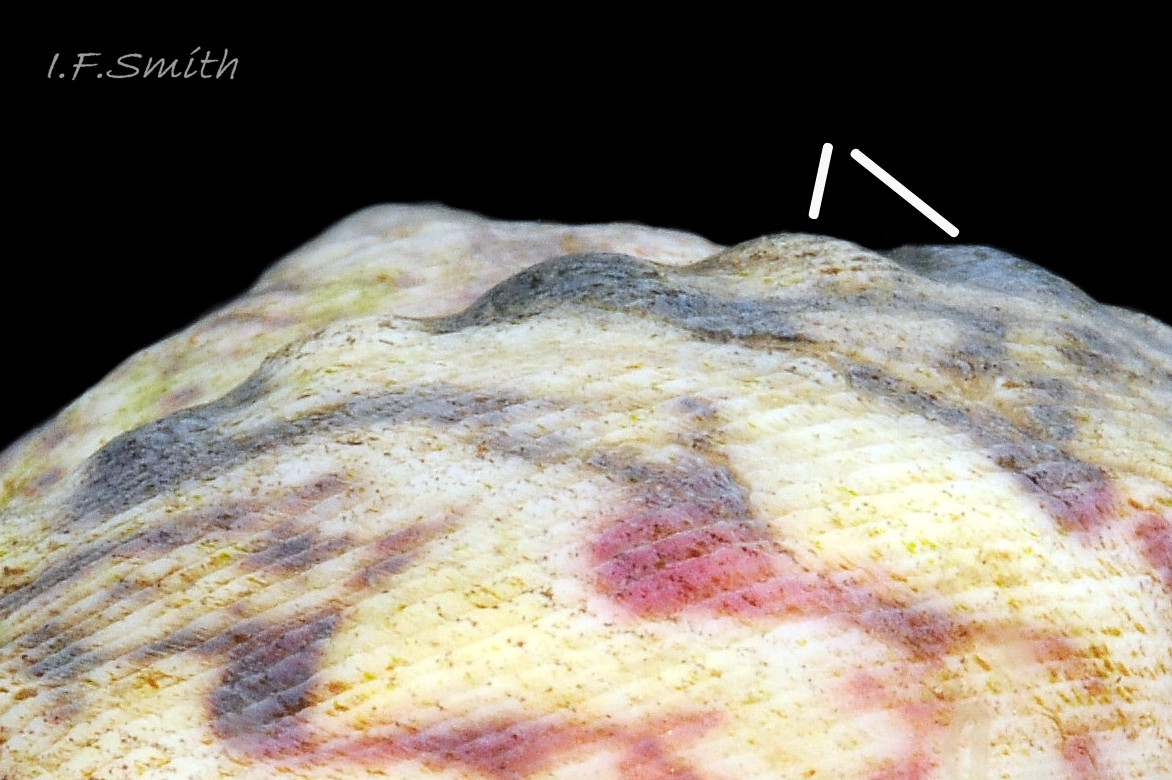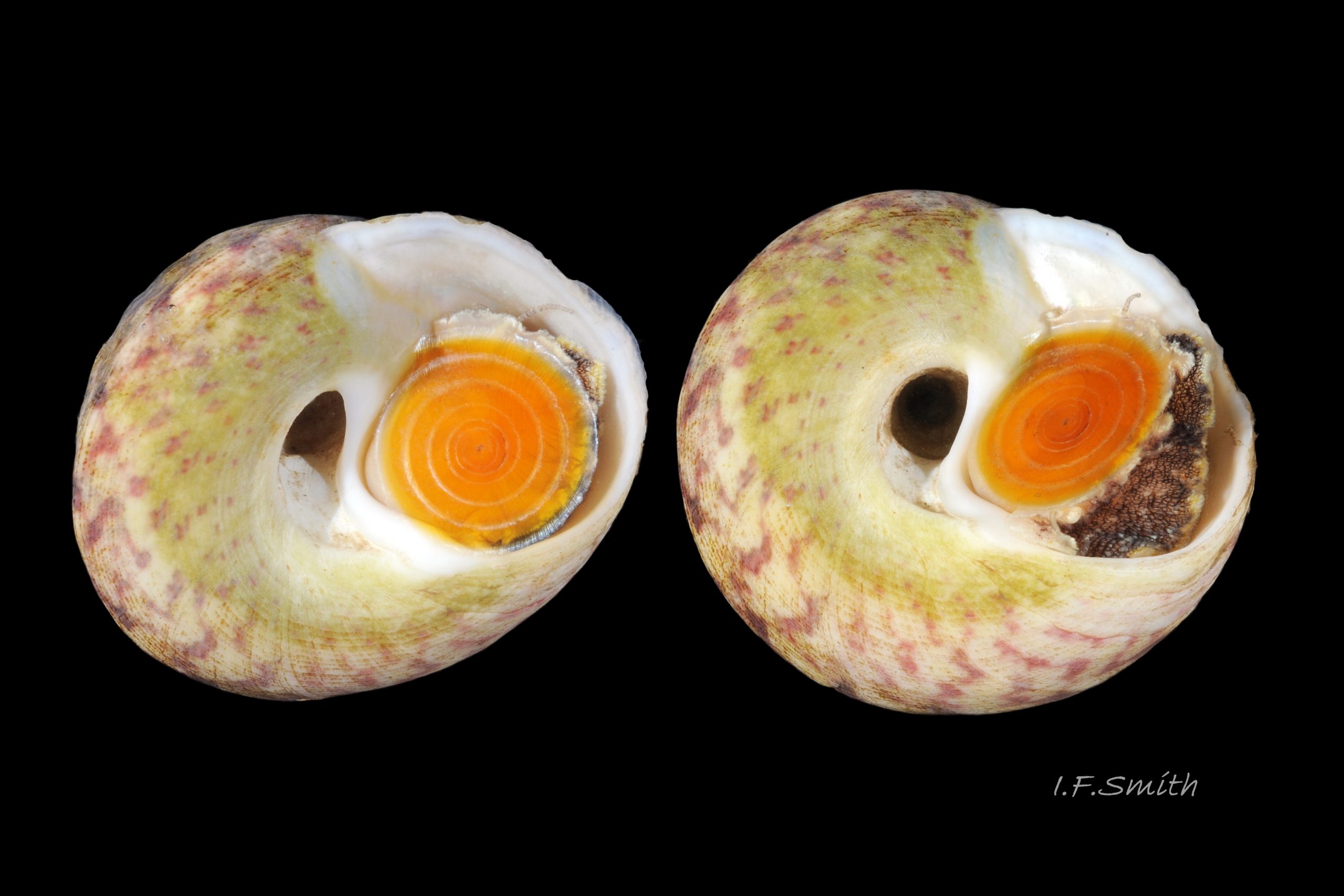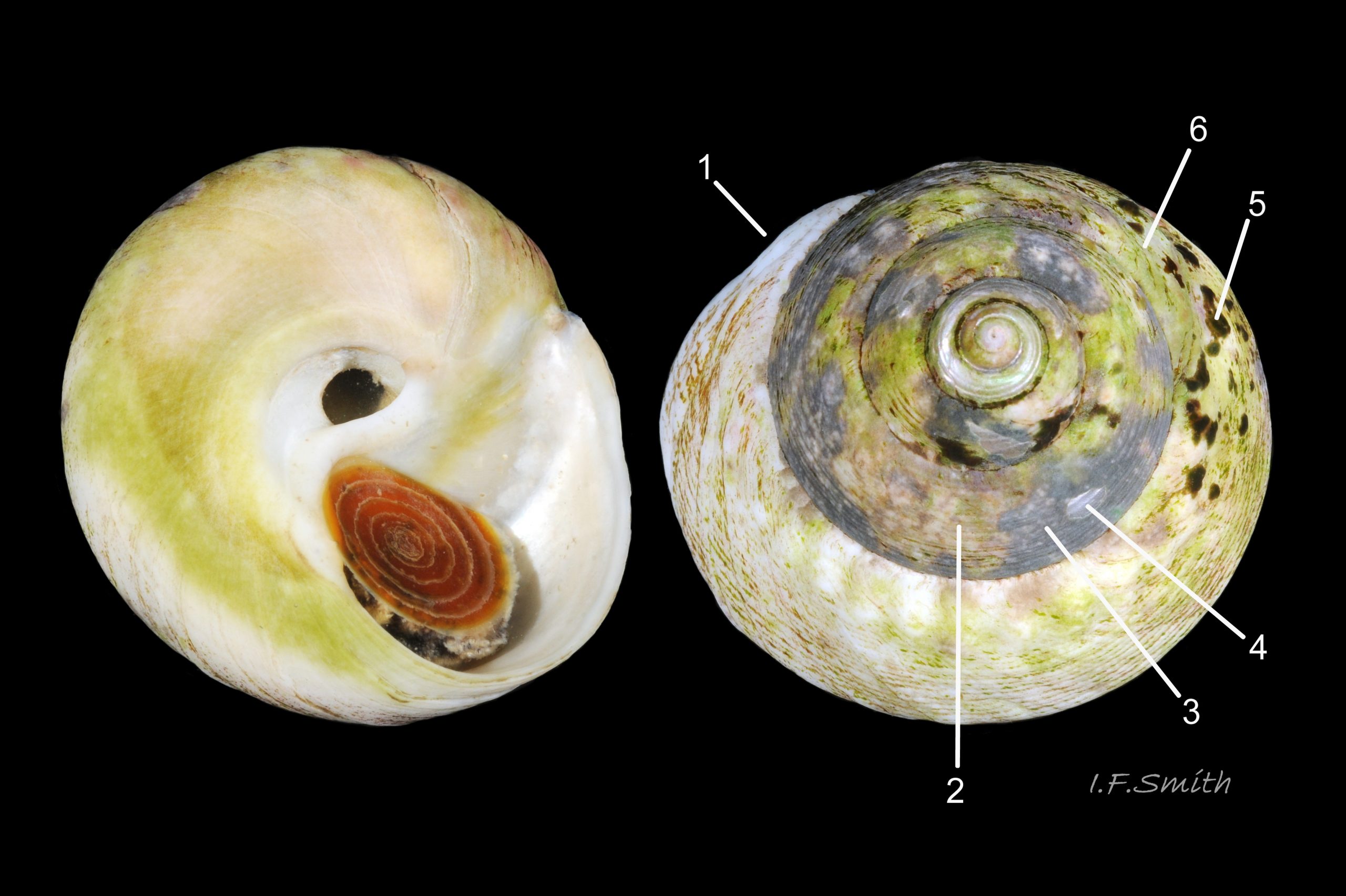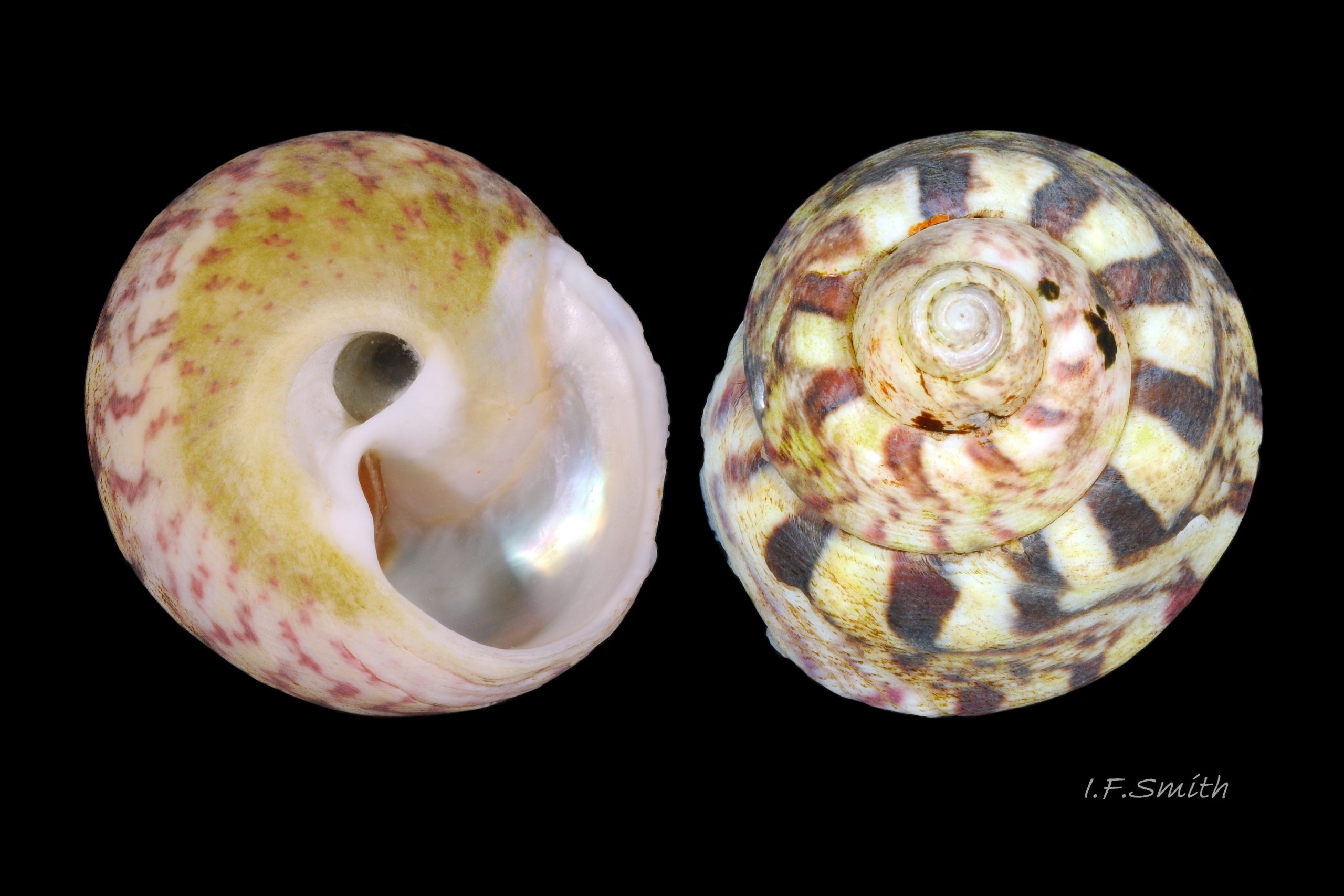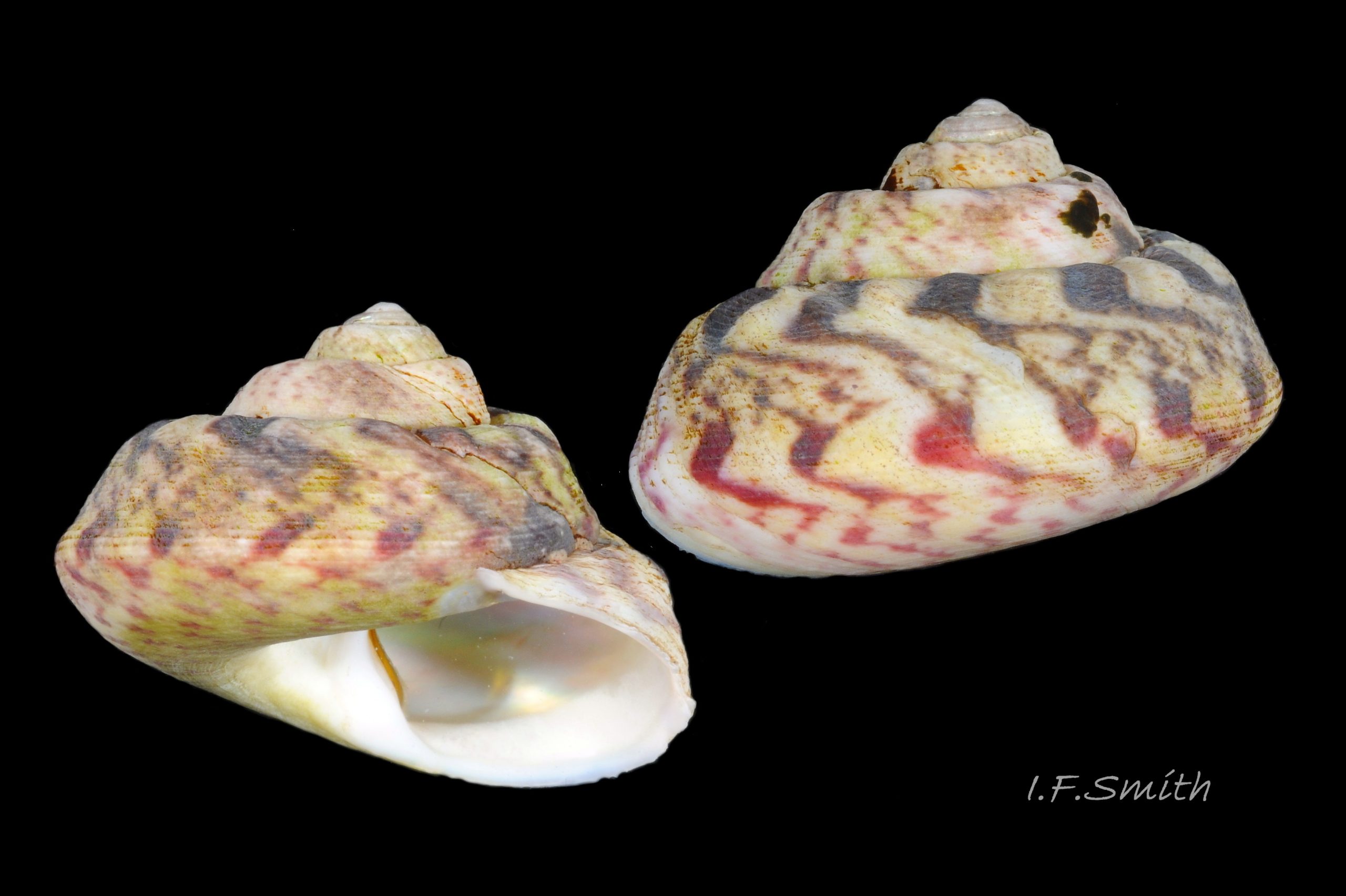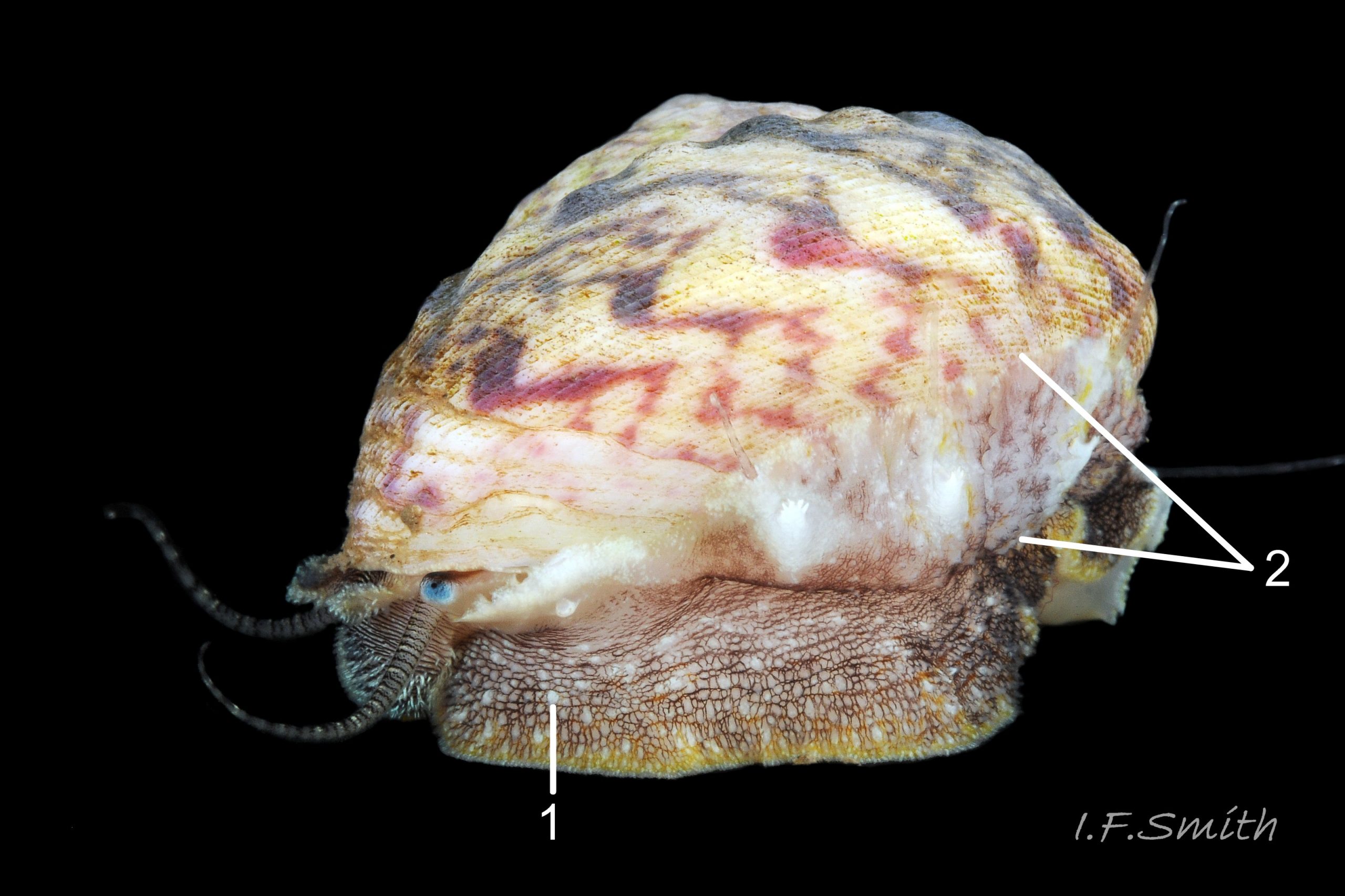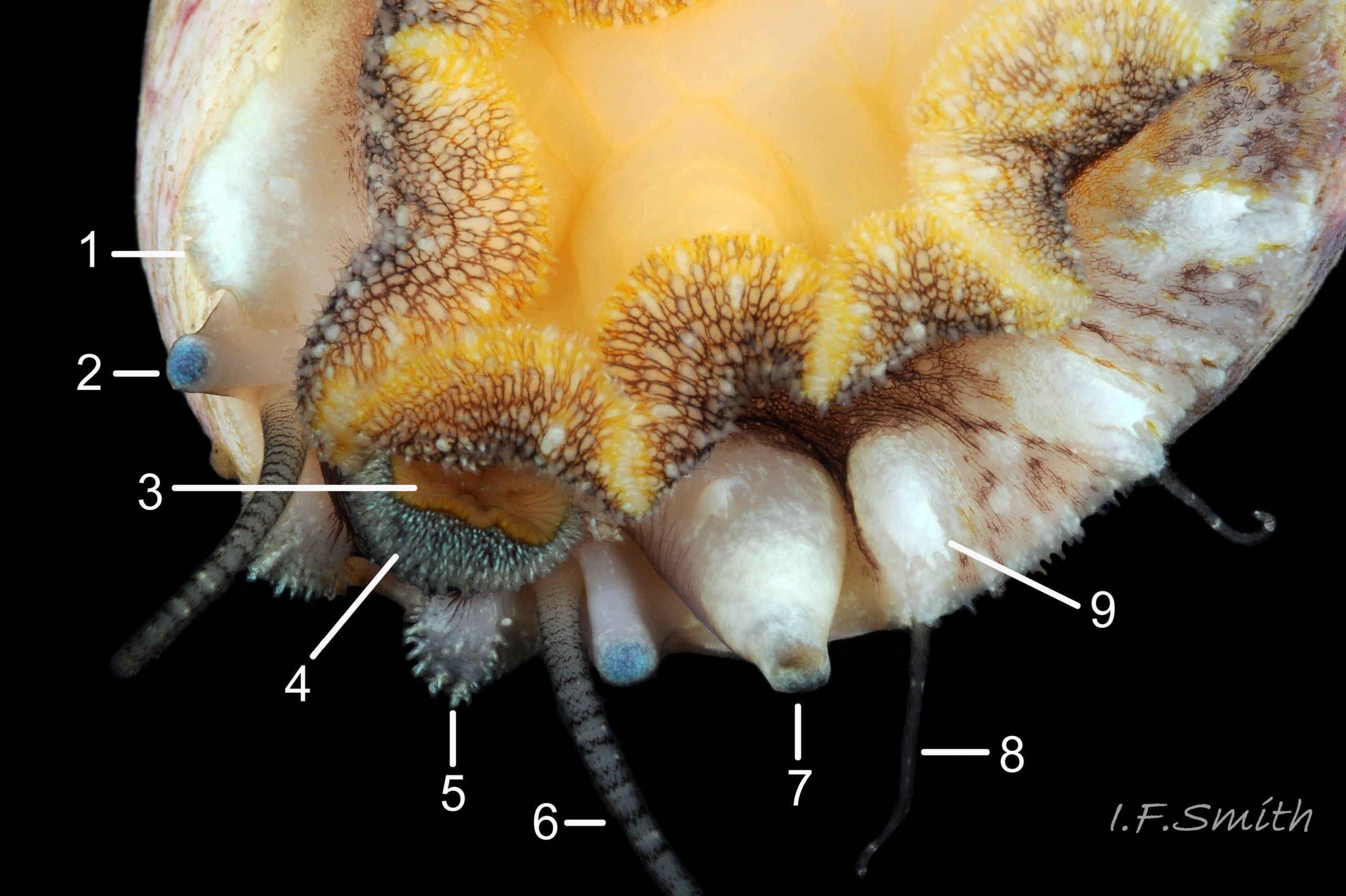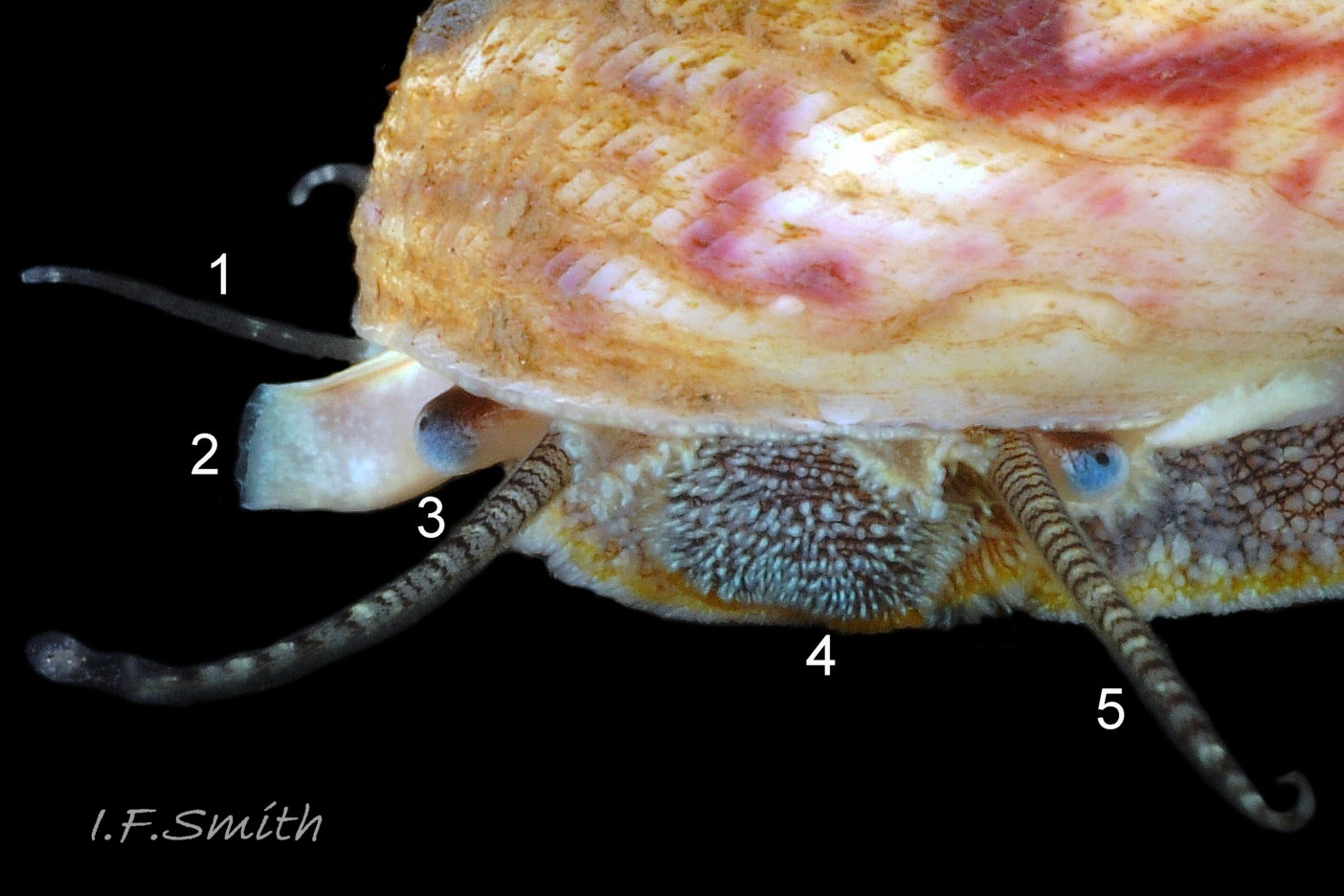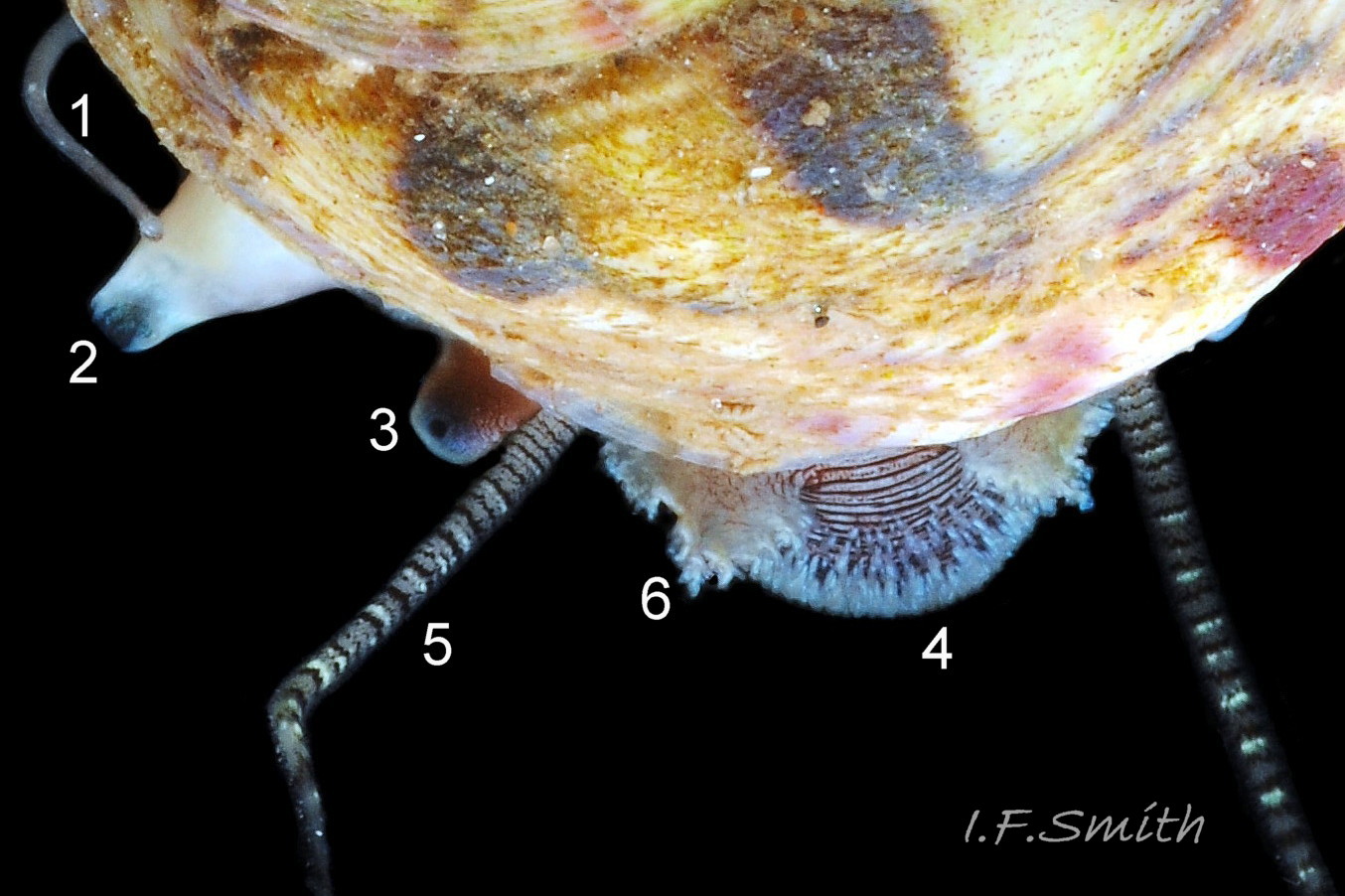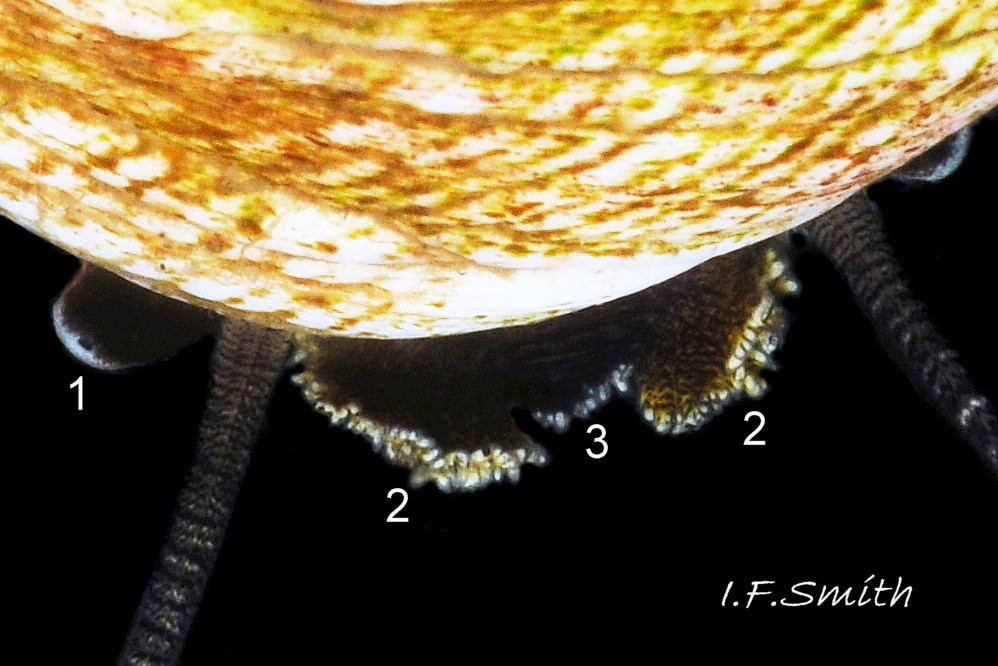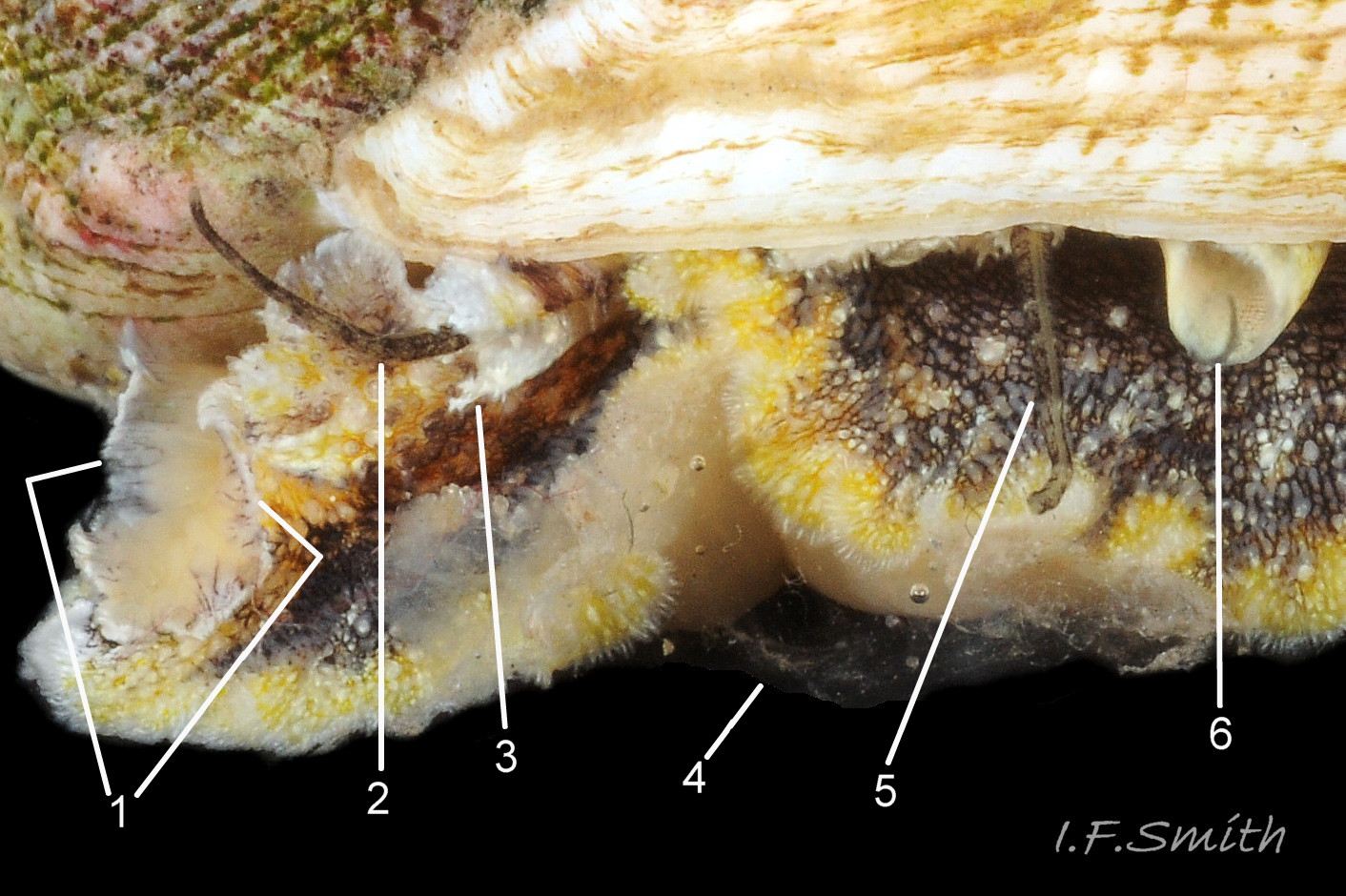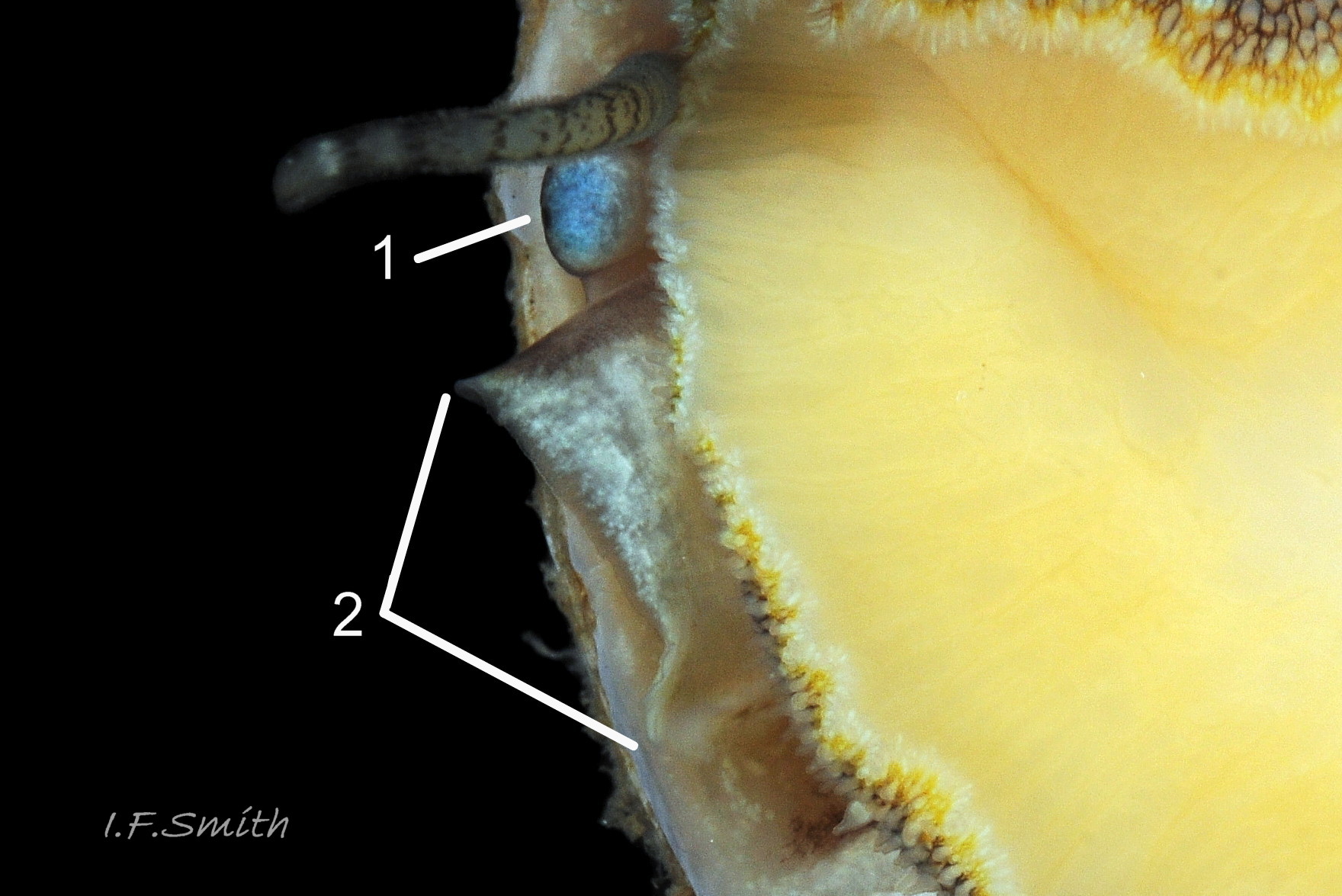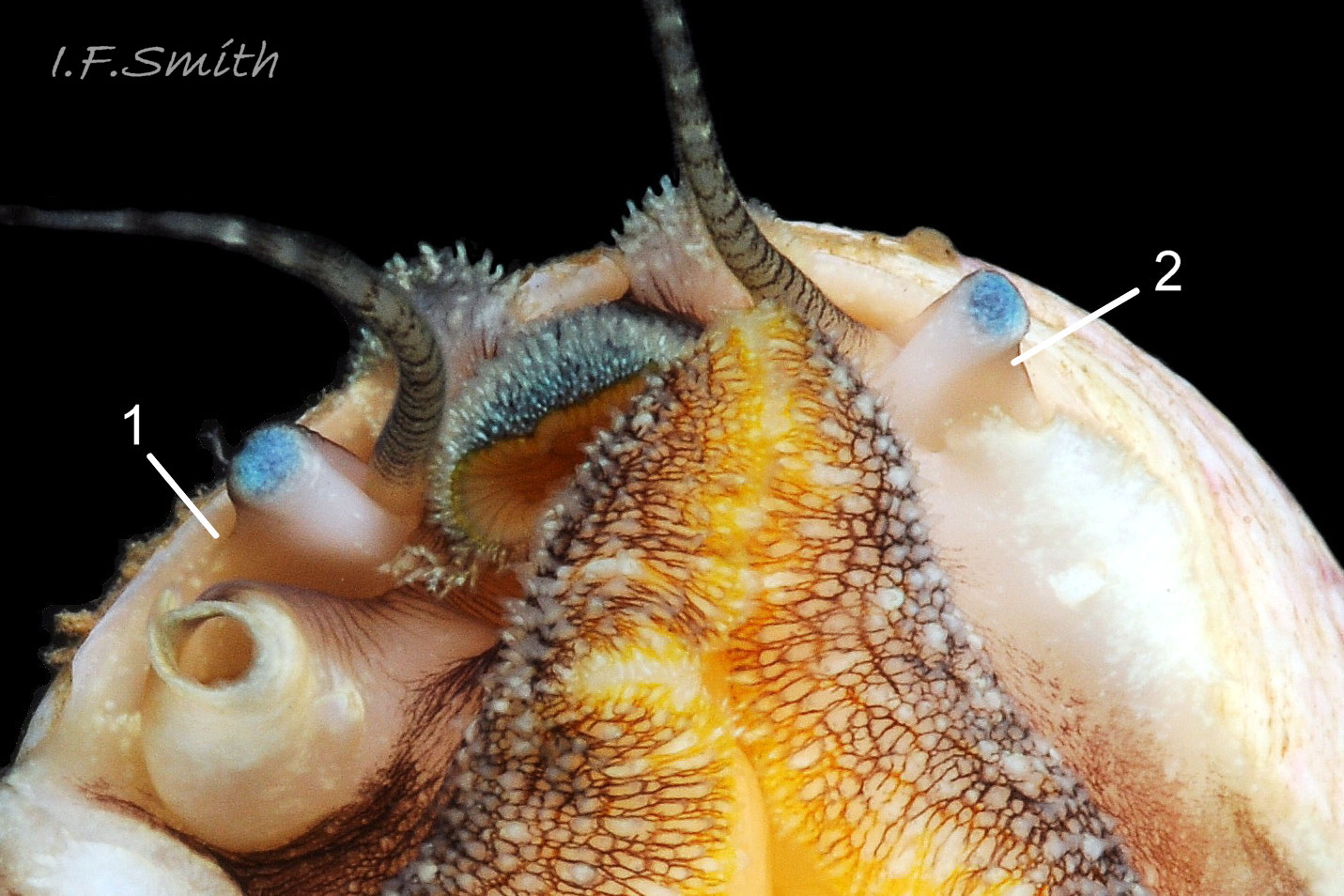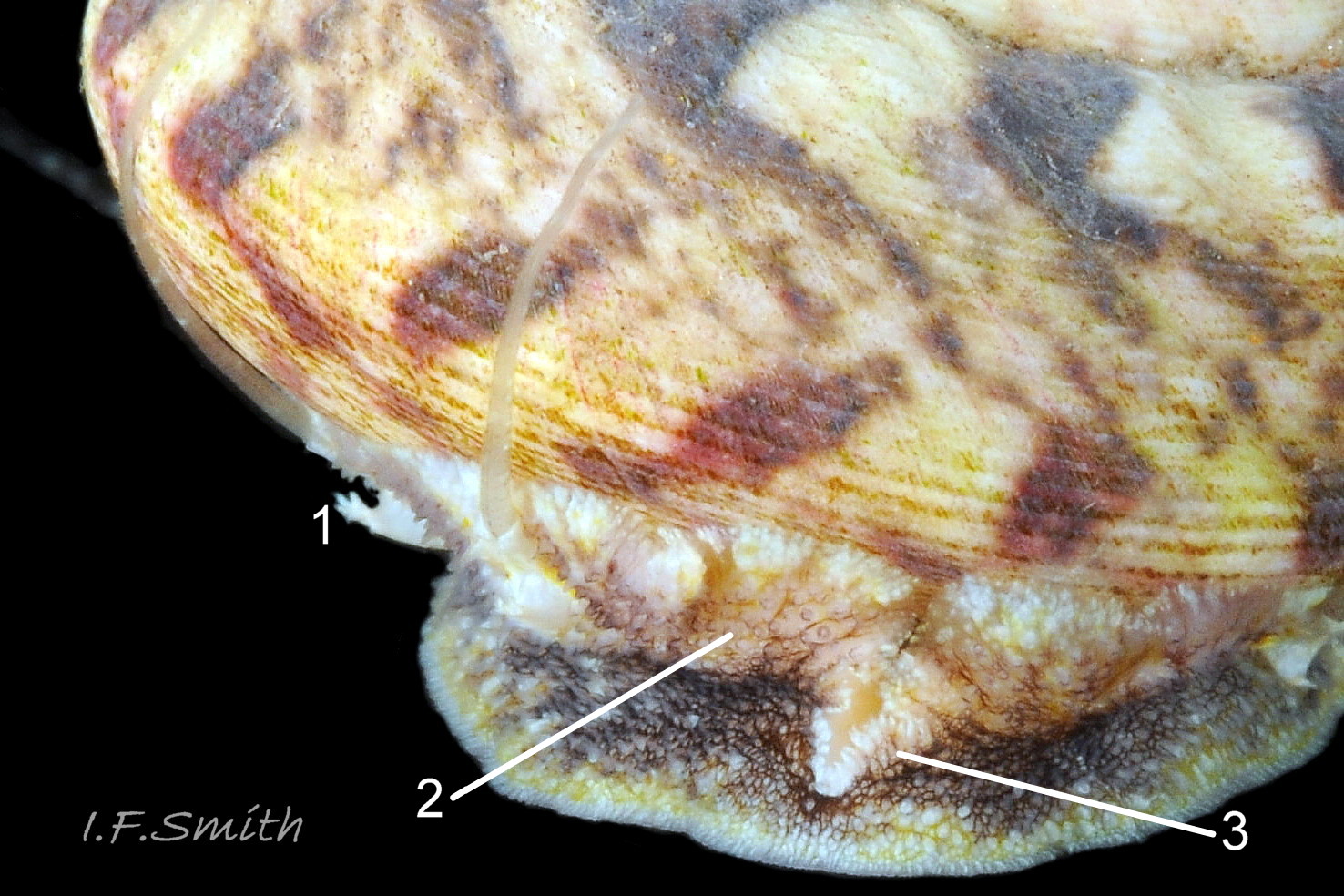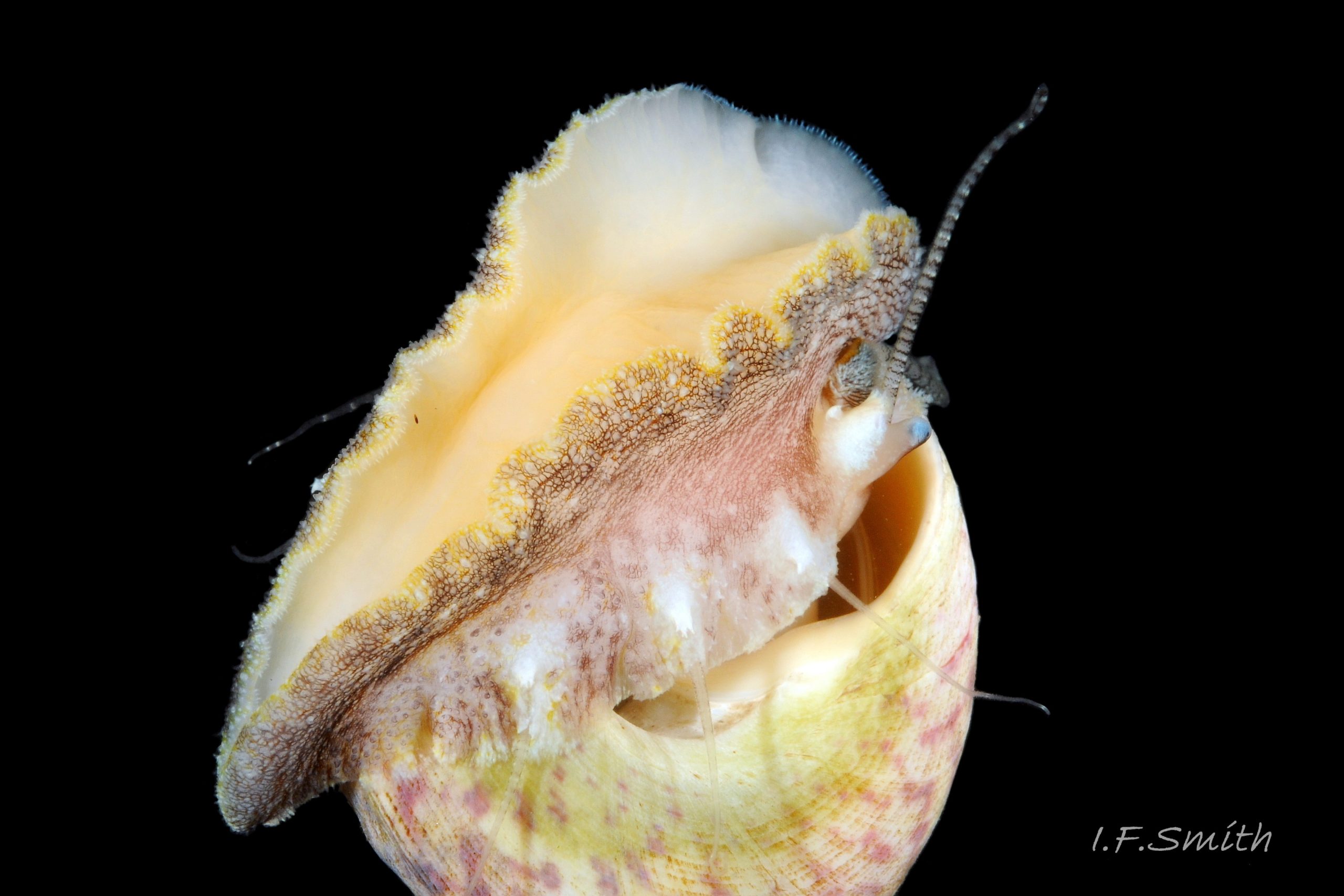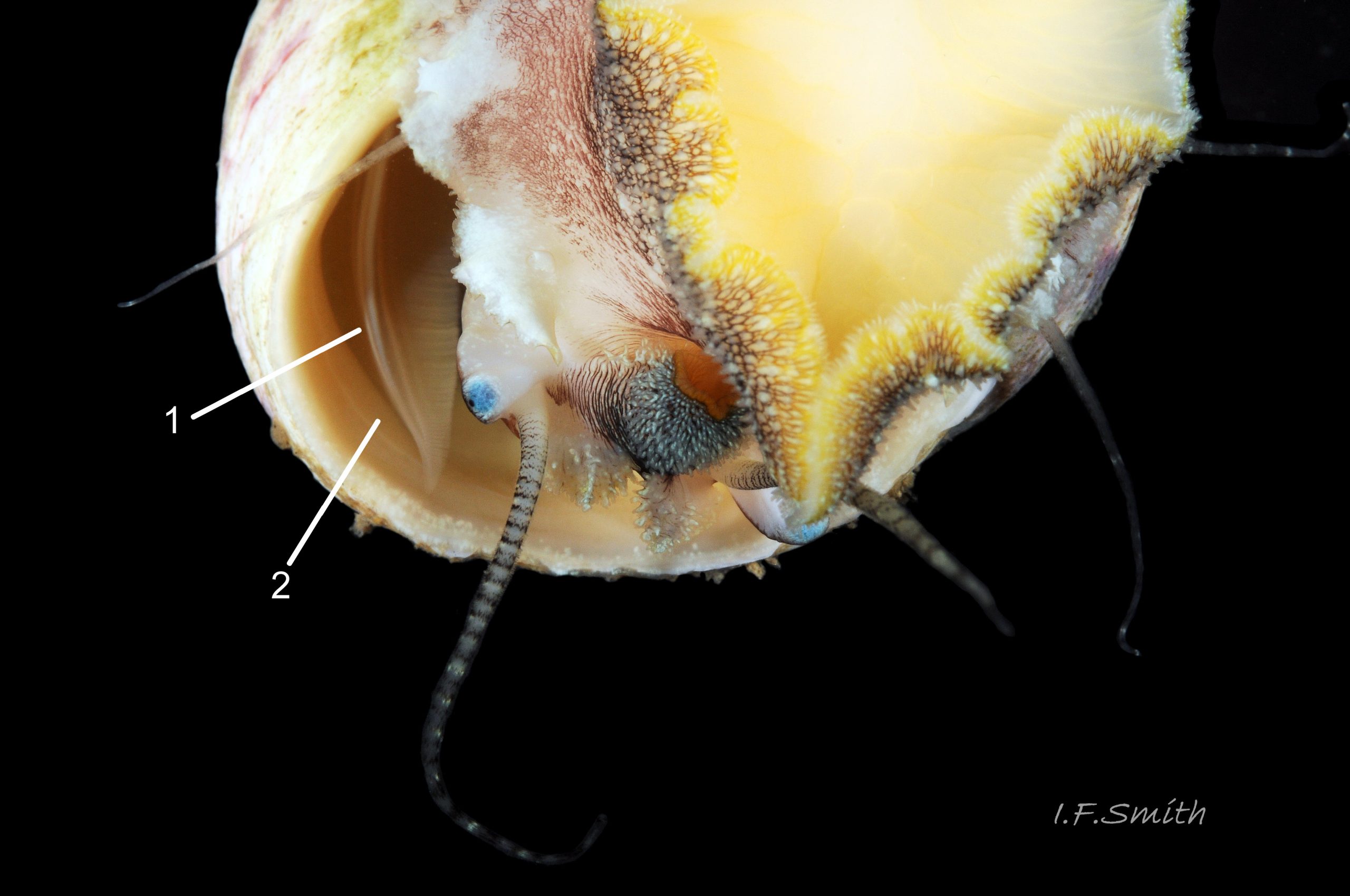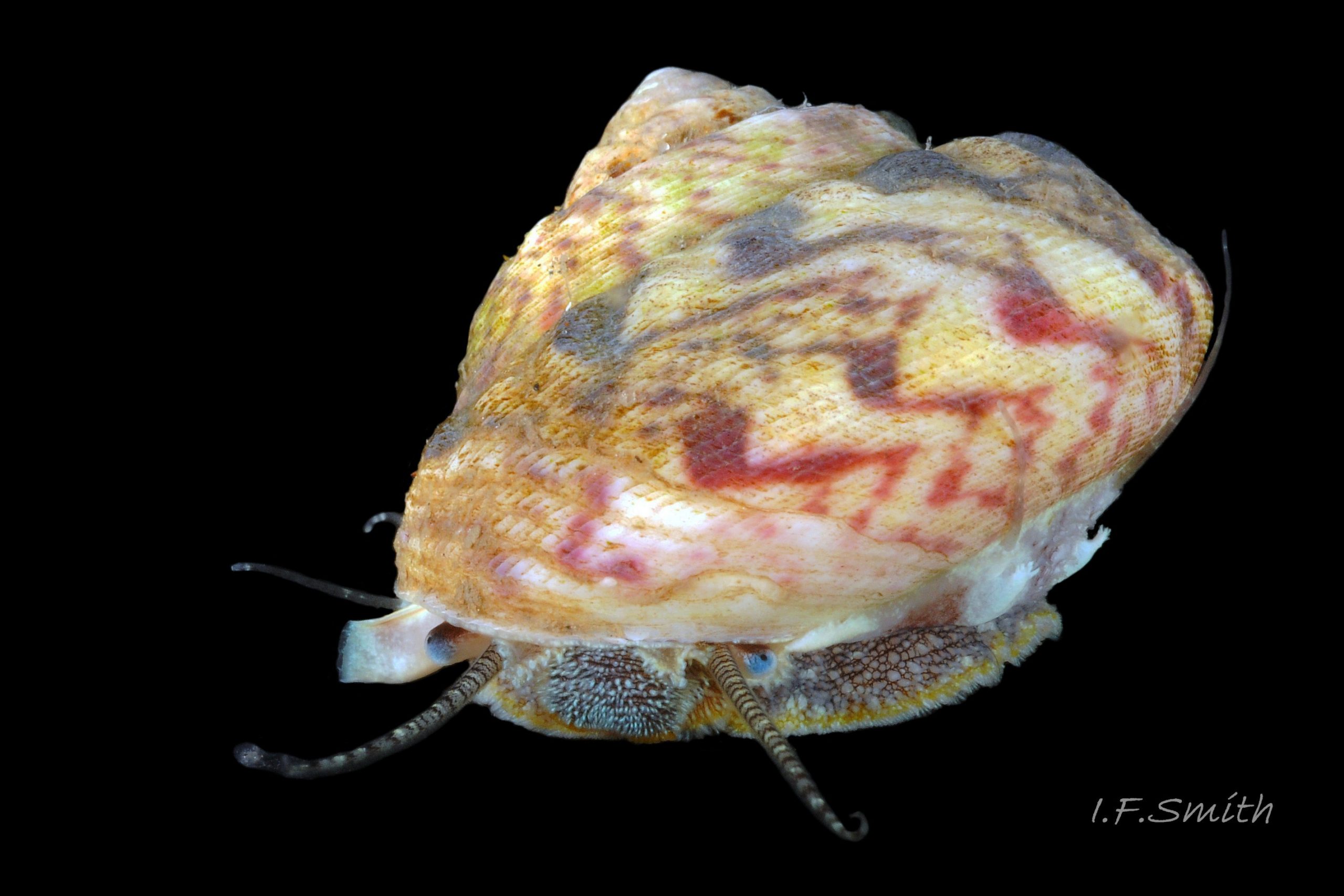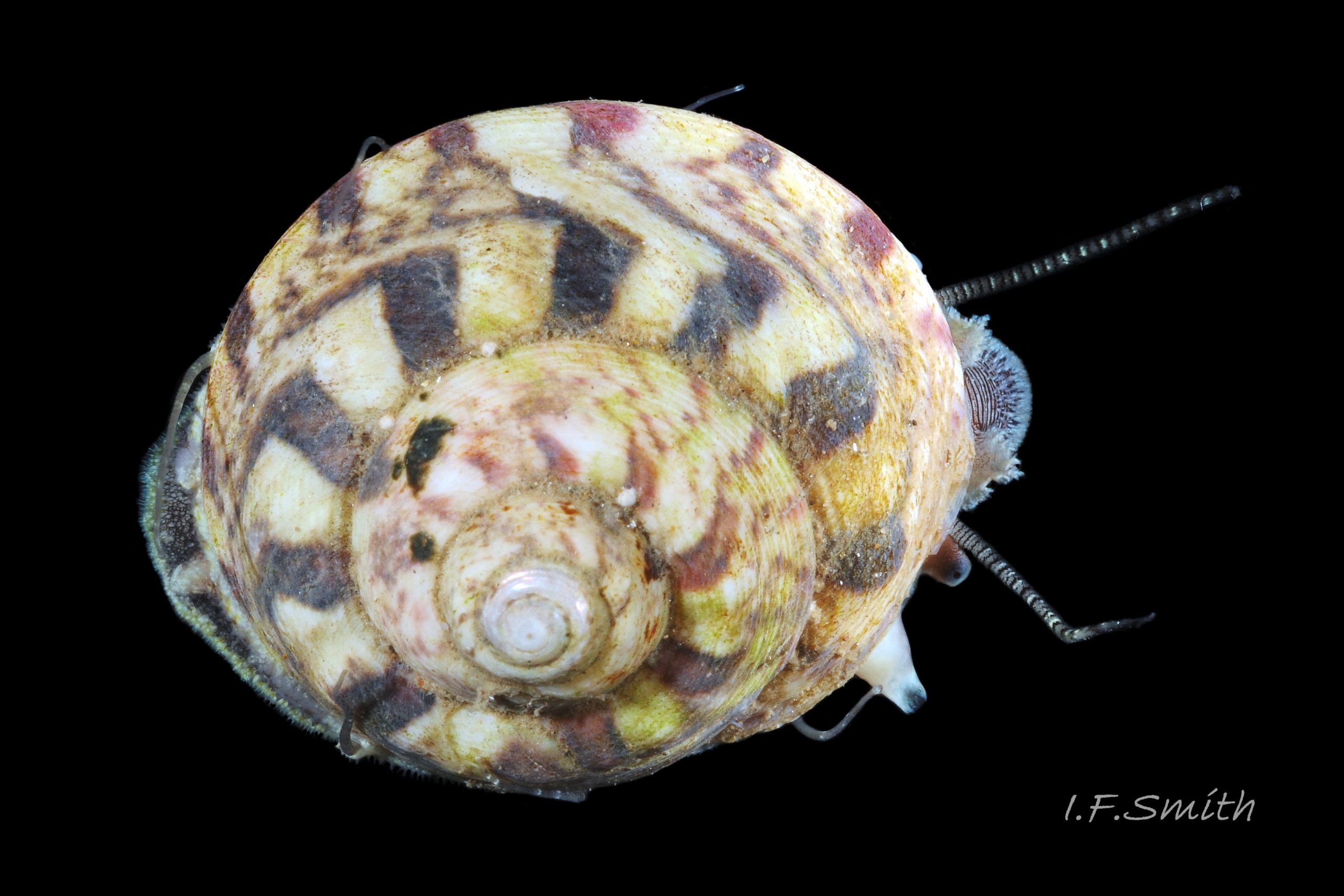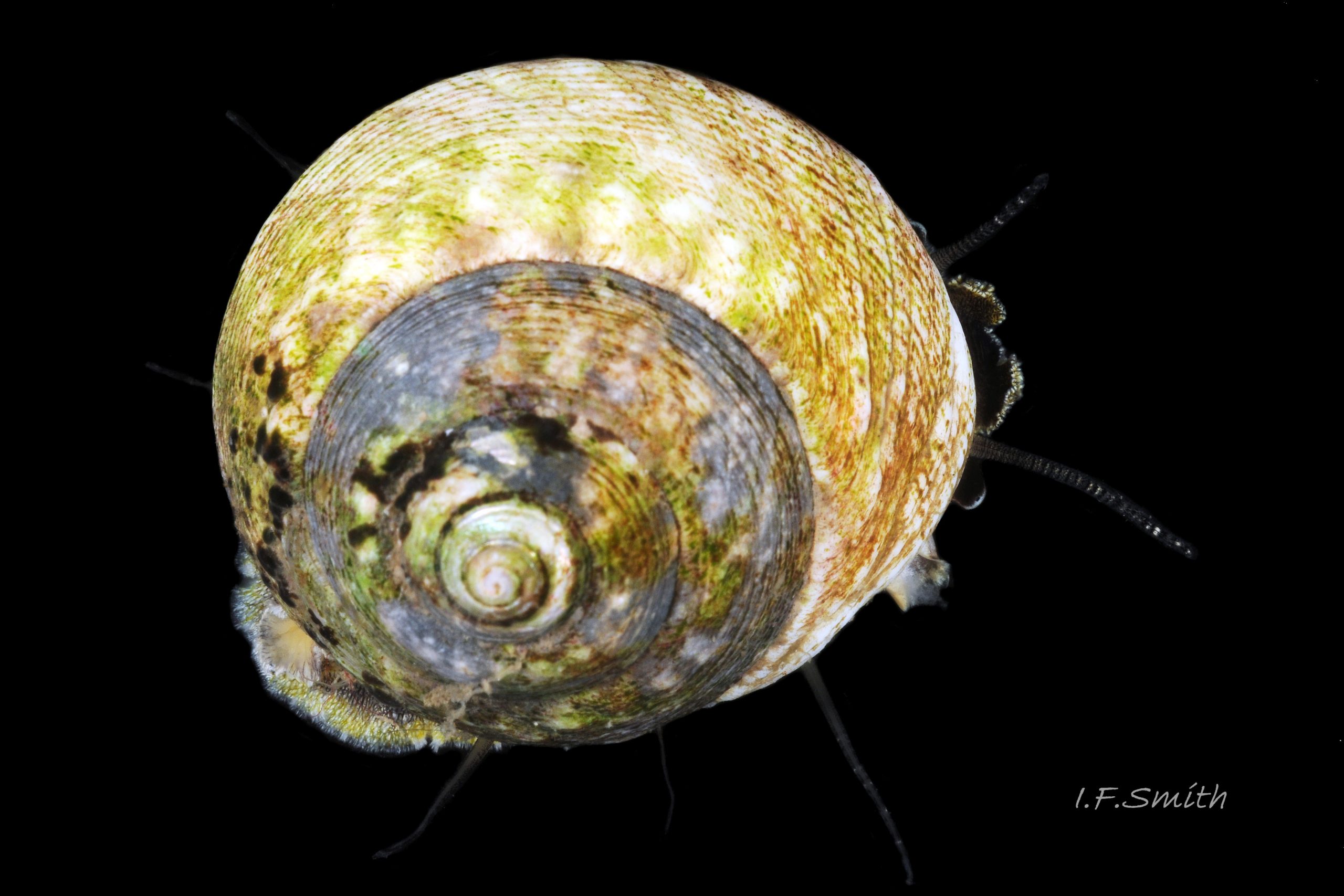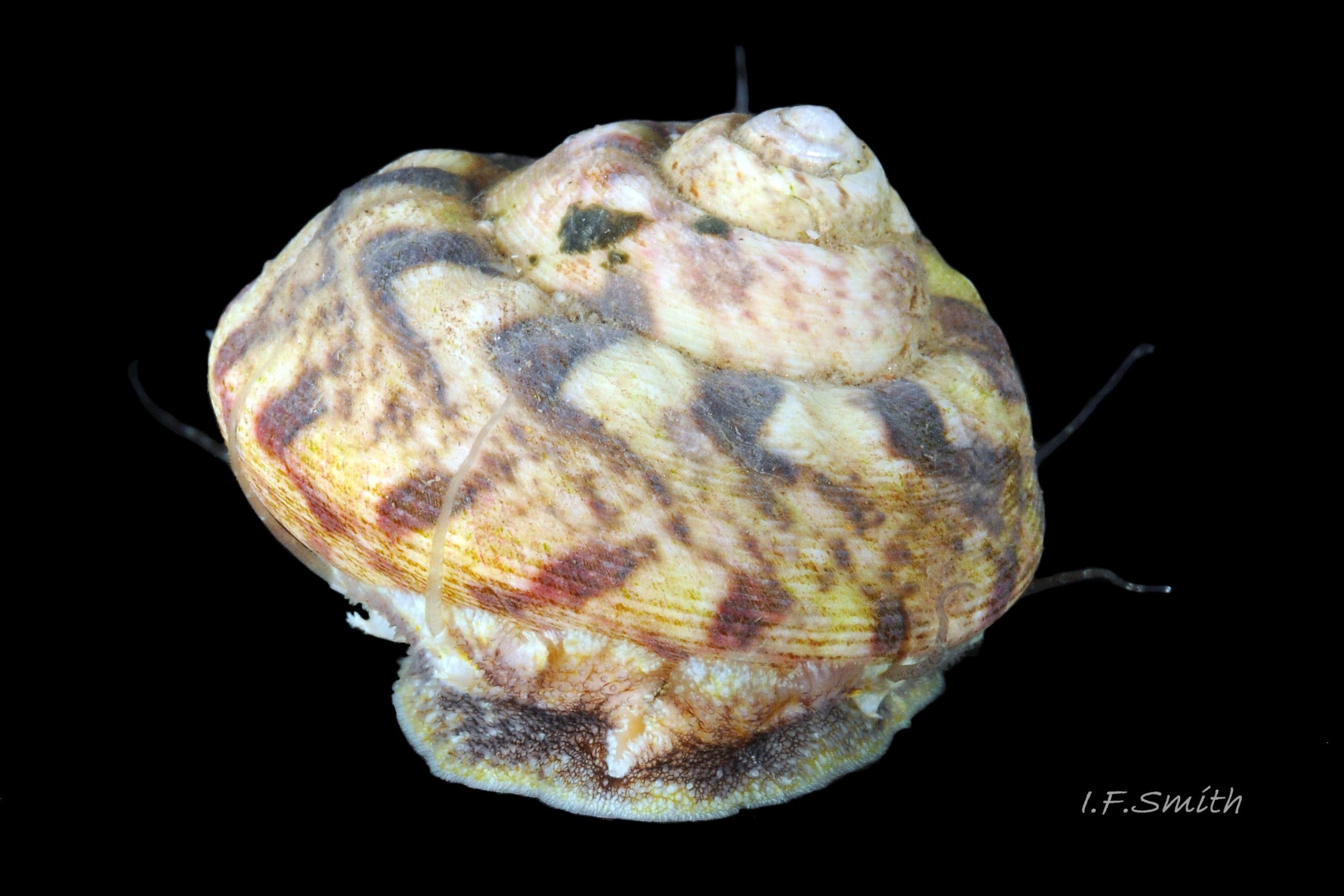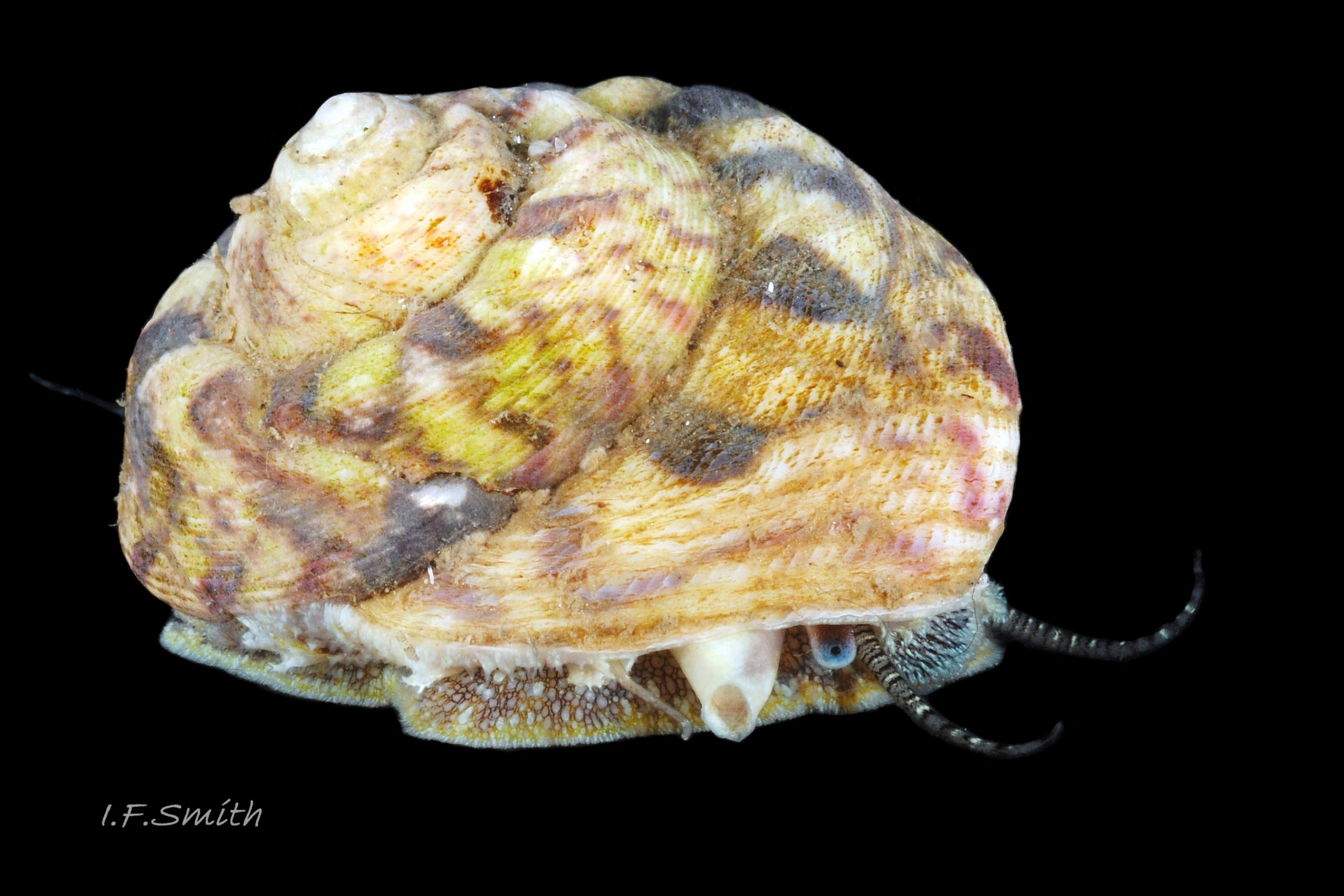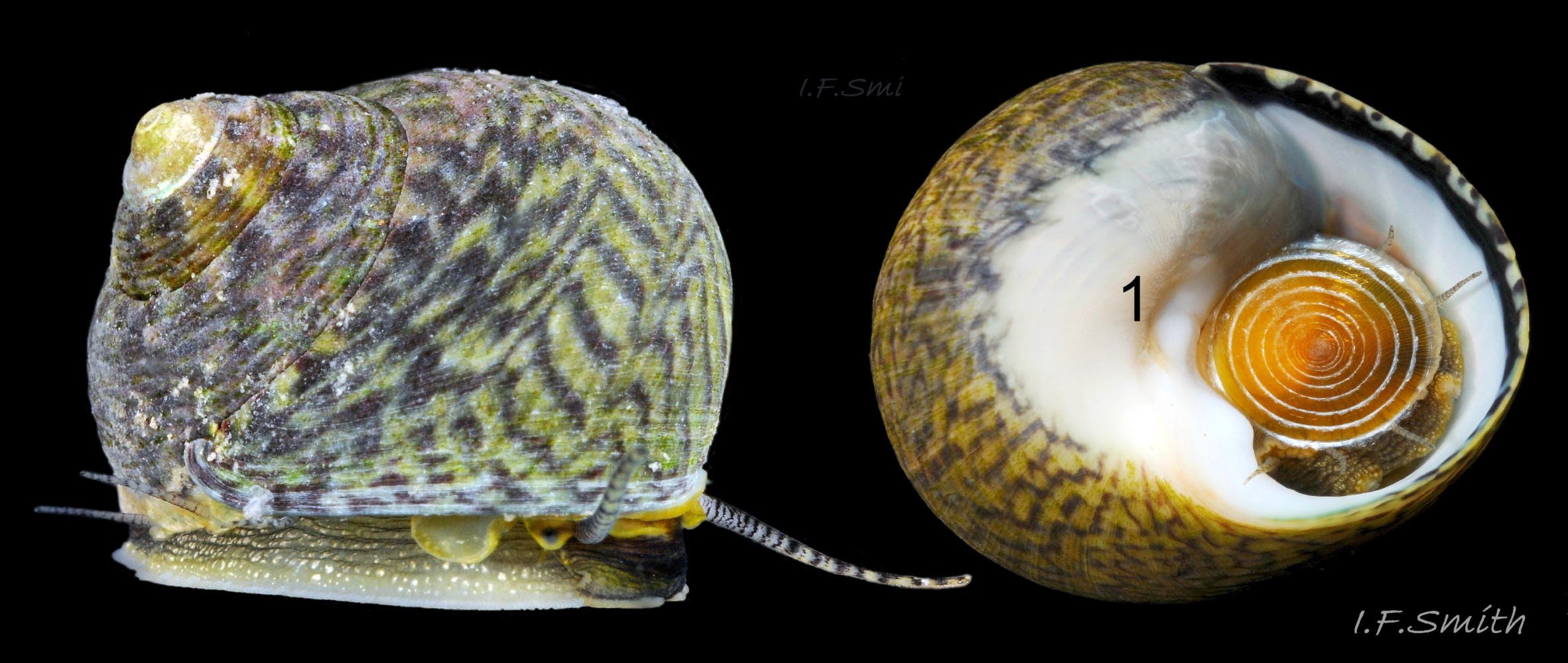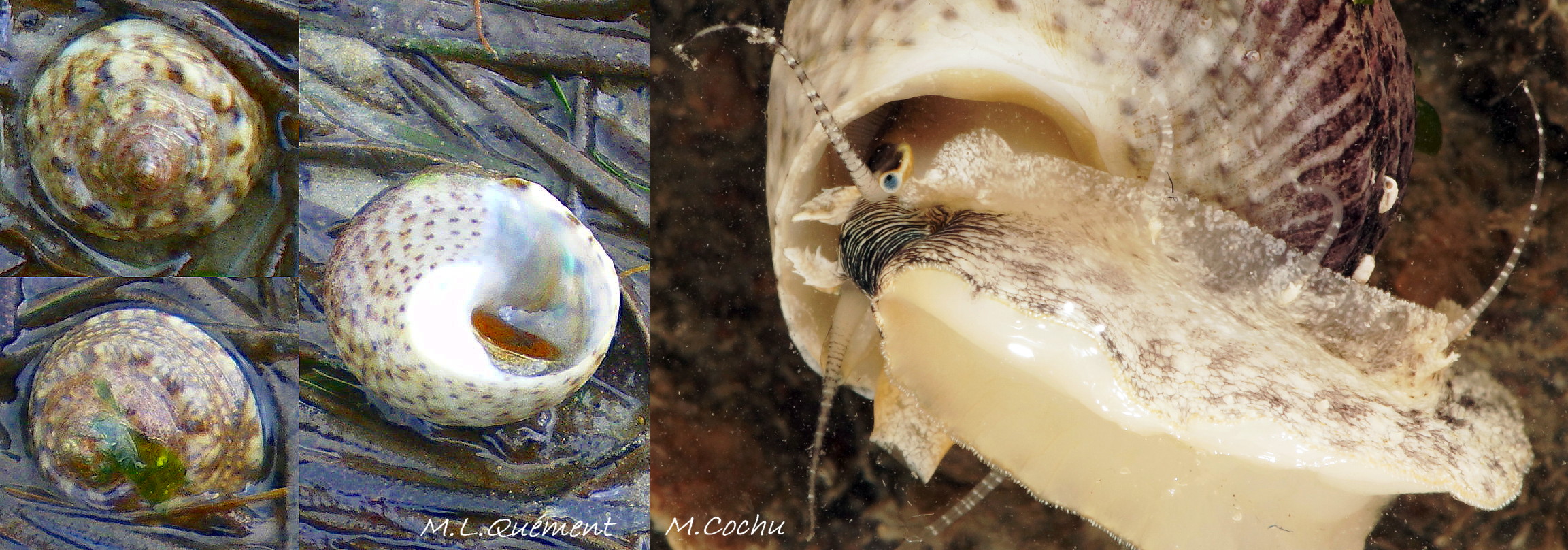Click image to enlarge with full caption. Main text below slider.
Gibbula magus (Linnaeus, 1758)
PDF available at www.researchgate.net/profile/Ian_Smith19/publications
Current taxonomy: World Register of Marine Species (WoRMS)
www.marinespecies.org/aphia.php?p=taxdetails&id=141790
Synonyms:Trochus magus (Linnaeus, 1758) [in Jeffreys, and Forbes & Hanley];
Meaning of name: Gibbula = [Latin] a little hump. magus = [shell resembles turban worn by] Persian wiseman/magician.
Vernacular: Turban top shell; Painted top shell; Giant top shell; Large top shell (English); Top môr mawr (Welsh); Geknobbelde tolhoren (Dutch); Peonza maga (Spanish); Zauberbuckel (German)
GLOSSARY below.
Shell description
Usually, breadth to 31mm, height to 25mm 01 Gibbula magus, exceptionally 35mm broad and 30mm high. Shell-walls thick. Sutures deep. Whorls flat or slightly convex, each with an abrupt adapical angle, forming a markedly stepped profile 02 Gibbula magus. Apical angle 80º – 100º. Body whorl angled about 100° at strong peripheral keel. Height about 80% of breadth . Spire small; body whorl height about 70% of shell height. Sculpture of distinct spiral ridges and narrow grooves; ridge on peripheral keel enlarged; on body whorl about seventeen ridges above keel and about twenty-five below 03 Gibbula magus. Ridges often smooth on intertidal specimens; often markedly imbricated sublittorally. Several transverse growth lines. Adapical step on each whorl has series of flexed elongate knobs that can form a cable pattern 04 Gibbula magus, but knobs may be inconspicuous when eroded or overlain by a colour pattern 05 Gibbula mag. Large conical umbilicus with wide comma-shaped groove leading into it 06 Gibbula magus . Aperture approximately D-shaped; about 40% of shell-height 02 Gibbula magus. Thin, curved, palatal (outer) lip. White columellar lip is basally flat and wide with slight rounded protuberance; narrower where it overhangs umbilicus 04 Gibbula magus. Parietal lip is a pale glaze on body whorl 04 Gibbula magus. Adapical angle of aperture is obtuse; about 160º 02 Gibbula magus.
External ground colour of opaque shell is matt white, often stained yellowish, greenish etc by epiphytic growths 03 Gibbula magus. , and old shells may become grey as outer layer erodes to reveal interior nacre 07 Gibbula magus. Radiating marks of various shades of red, including red-black 08 Gibbula magus, are found on shells from southern Europe (Greek examples by A.Trifilis) flic.kr/p/7YLoPh and the English channel, but further north in Wales and Scotland the majority of some populations lack red markings. Internally, shell is glossy-white apart from matt-white band bordering lip , often with a pinkish tinge on red-patterned specimens, 08 Gibbula magus. & 09 Gibbula magus . No internal red marks. Circular spiral operculum with many narrow coils 06 Gibbula magus, transparent horn colour, darkening with age/growth; pale opercular disc usually visible through operculum of live specimens.
Body description
Ground colour of dorsal surfaces of head-foot white, often faintly tinted pinkish or yellowish; overlaid with dense network of brown to purple-black 10 Gibbula magus. Large Snout ends in circular yellow tip with a vertical slit mouth with diagonal slit extensions at each end 11 Gibbula magus. Exterior surface of snout has transverse brown to purple-black lines, and distal half has dense beard of long bright blue papillae 12 Gibbula magus & 13 Gibbula magus . Cephalic tentacles long, translucent brownish-white, with encircling black and opaque-white jagged rings; unobtrusive, fine, longitudinal, dorsal, black line in slight dorsal groove often only partially visible; coating of dense fine setae visible under magnification. Between bases of cephalic tentacles is a pair of large cephalic lappets with varying amounts of orange or brown 13 Gibbula magus & 14 Gibbula magus, and edged with prominent fringe of often yellowish and blue lobes. Eye on stout peduncle at base of each cephalic tentacle; peduncle orange to dark-brown dorsally and whitish ventrally apart from bright blue terminal area that extends slightly onto dorsum; small black “pupil” in blue area near dorsal edge of truncated tip 12 Gibbula magus & 14 Gibbula magus. Both cephalic lappets pass over base of cephalic tentacle to connect with eye-peduncle. Large neck-lobe behind each eye. Yellowish-white to orange right neck-lobe has smooth edge and is usually curved to form complete bottle-necked siphon for exhalent water, faeces and reproductive products 11 Gibbula magus & 15 Gibbula magus ; occasionally opened-out flat 16 Gibbula magus. Whitish to orange left neck-lobe has scalloped edge to assist filtering out of large debris from inhalent water. Ventral surface of each neck-lobe has substantial whitish cylindrical peg. Each eye-peduncle is connected to its adjacent neck lobe/epipodium by a connecting flap 17 Gibbula magus. Dorsal surface of foot white, often faintly tinted pinkish or yellowish, except peripheral border bright yellow; all overlaid with dense network of brown to purple-black 10 Gibbula magus and densely covered with whitish tubercles. Epipodium an extensive veil on each side of foot, united with neck-lobes ; on live animal usually held erect against surface of shell so its ventral surface on view and upper body concealed 10 Gibbula magus; protection from sand abrasion by epipodium allows algae to grow on base of shell 06 Gibbula magus. Ventral surface of epipodium has many tubercles 18 Gibbula magus; paler than dorsum of foot as brown reticulated pattern less intense, and large simply white and sulphur-yellow areas lack pattern. When epipodium from each side reaches the metapodium it becomes a free-standing erect crest that meets the other at the posterior to form a ‘V’; prominent when foot extended 15 Gibbula magus, small when foot contracted 18 Gibbula magus. Each epipodium bears three translucent tawny-white or yellow epipodial tentacles with a pale longitudinal dorsal line, and sometimes indistinct pale-brown rings and reticulation 15 Gibbula magus. Each tentacle arises from a white jagged sheath with an adjacent white, spiked, sensory lobe 15 Gibbula magus & 18 Gibbula magus. Opercular lobe, not enclosing any of operculum edge, visible as pale patch through transparent operculum when animal retracted into shell 06 Gibbula magus. Sole varies yellow to white, depending on degree of compression/extension; divided by central longitudinal furrow; periphery has fringe of papillae 19 Gibbula magus. Mantle dull-yellow. Large, dull-yellow, canoe-shaped ctenidium 20 Gibbula magus within mantle cavity. Fertilization external, so no penis on males.
Other images of whole animals:
21 Gibbula magus Anterior/left view of whole animal. Source of extract 12 Gibbula magus
22 Gibbula magus. Dorsal view of whole animal. Source of extract 13 Gibbula magus.
23 Gibbula magus. Dorsal view of whole animal. Source of extract 14 Gibbula magus. .
24 Gibbula magus Ventral view of whole animal. Source of extract 17 Gibbula magus.
25 Gibbula magus. Posterior view of whole animal. Source of extract 18 Gibbula magus.
26 Gibbula magus. Right side view of whole animal.
Key identification features
Gibbula magus
* Opaque white shell 04 Gibbula magus, sometimes with reddish marks 08 Gibbula magus.
* Markedly stepped shell-profile 09 Gibbula magus.
* Large conical umbilicus with wide comma-shaped groove leading into it 06 Gibbula magus.
* Snout has transverse brown to purple-black lines 13 Gibbula magus, and distal half has dense beard of long bright blue papillae 12 Gibbula magus.
* Black eye-pupil in blue area on stout peduncle 12 Gibbula magus.
* Mainly sublittoral, but locally common at ELWS in favoured sheltered sites in Scilly Isles, Cardigan Bay, Connemara and Orkney. On stable sand, muddy-sand, maerl and gravel; sometimes on rock.
Similar species
Phorcus lineatus
* Shell, ground colour shades of buff 07 Phorcus lineatus , yellow 08 Phorcus lineatus , brown 01 Phorcus lineatus and/or green 09 Phorcus lineatus . Darker, more or less zig-zag, transverse streaks of dark-brown, -green, -grey or –reddish purple run across the whorls, parallel to growth lines.
* Shell-profile not stepped.
* Umbilicus completely sealed over by time 5mm wide, often leaving a dip in columella 04 Phorcus lineatus (Occasionally narrow, open crack 5Pl 05 Phorcus lineatus . Iberian specimens often have open umbilicus).
* Snout black or grey, lacks dense beard of long bright blue papillae 14 Phorcus lineatus
* Black eye-pupil on red or yellow peduncle 14 Phorcus lineatus
* Upper rocky shores between Isle of Wight and Llandudno, and most of Ireland.
Gibbula umbilicalis
* Shell always has broad red to reddish-purple bands radiating from apex across the whorls 05 Gibbula umbilicalis. .
* Shell always has a large round umbilicus, but no wide comma-shaped groove leading into it 04 Steromphala umbilicalis .
* Shell-profile not stepped 02 Steromphala umbilicalis .
* Snout short, yellowish or greenish with dense transverse dark purple lines, lacks dense beard of long bight blue papillae 10Gu 10 Steromphala umbilicalis.
* Middle levels of rocky shores from Kent along south and west coasts round onto north coast Scotland, with a few records on west coast of Orkney.
Gibbula cineraria
* Shell has grey or bluish grey bands radiating from apex across the whorls 03 Steromphala cineraria .
* Umbilicus progressively narrows with age. Adult shell may have very restricted 26 Steromphala cineraria. or completely closed umbilicus 27 Steromphala cineraria, but juveniles 27 Comparison small G. umbilicalis and G. cineraria. may have large round umbilicus.
* Shell profile of fully grown 15mm high G. cineraria may be like traditional bee-hive 06 Steromphala cineraria , but not stepped.
* Snout short, yellowish or brownish with transverse brown lines, lacks dense beard of long bright blue papillae 10 Steromphala cineraria.
Gibbula albida
* Opaque white shell, sometimes with reddish marks www.conchology.be/?t=66&species=Gibbula+albida .
* Stepped shell-profile.
* Some shells have umbilicus with comma-shaped groove leading into it, www.animalbase.uni-goettingen.de/zooweb/servlet/AnimalBas… but smaller than G. magus, and often closed by callus. nature22.com/estran22/mollusques/gasteropodes/gasteropode…
* Soft parts resemble G. magus; eye-pupil in blue area on peduncle, and snout has transverse brown lines but lacks dense beard of long bright blue papillae. nature22.com/estran22/mollusques/gasteropodes/gasteropode…
* Brittany southwards; not Britain.
Habits and ecology
Usually on stable sublittoral rough bottoms, muddy sand or gravel. In Britain and Ireland, locally common at ELWS at a few sites with fully marine salinity and shelter from wave action in Scilly Isles, Cardigan Bay, Connemara and northern Scotland. Reported shore substrates include sand (T.Pearman) Gibbula magus , mixed sand and stones, rocks, muddy sand, and maerl www.habitas.org.uk/marinelife/species.asp?item=W1890 .
Respiration, cilia on fringed left neck-lobe vibrate to create inhalent current to large canoe-shape ctenidium within mantle cavity 20 Gibbula magus. Fringe probably acts as guard against detritus and may sense poor water conditions. Cilia on right neck-lobe create exhalent current for respiratory water, ova or sperm, and faeces; bottle-neck probably increases speed of expulsion. Locomotion enabled by ditaxic direct compression waves on either side of central division on sole 19 Gibbula magus; turning caused by different rates of wave flow on either side of central furrow. Exudes copious mucus to assist movement over soft sediment 01 Gibbula magus. Feeds by grazing microphytes (diatoms etc) from substrate with its radula.Breeds spring and autumn (Plymouth), June (Roscoff); dates vary at different locations. External fertilization occurs as ova released individually via right neck-lobe from mantle cavity. Brief free living trochophore stage; little else known of early stages, but lack of capture in plankton nets suggests weak, or no, planktonic veliger activity.
Distribution and status
Shetland to Canary Islands, Mediterranean and Black Sea, not North Sea or Baltic. GBIF map www.gbif.org/species/5190299 . Common sublittorally in Britain on south and west coasts between Kent and Shetland; not North Sea or Liverpool Bay. Most of Ireland. U.K. map NBN species.nbnatlas.org/species/NBNSYS0000175457
.
Acknowledgements
I thank Florence Cochu, Marc Cochu and Michel Le Quément for use of their images of Gibbula albida.
Links and references
Estran 22, faune et flore de le zone de la balancement de marées en Côtes d’Armor nature22.com/estran22/mollusques/gasteropodes/gasteropode…
Forbes, E. & Hanley S. 1849-53. A history of the British mollusca and their shells. vol. 2 (1849), London, van Voorst. (As Trochus magus; Free pdf at archive.org/stream/historyofbritish02forb#page/522/mode/2up Use slide at base of page to select pp.522-525.)
Fretter, V. and Graham, A. 1962. British prosobranch molluscs. London, Ray Society.
Fretter, V. and Graham, A. 1977. The prosobranch molluscs of Britain and Denmark. Part 2 – Trochacea. Suppl. 3, J. Moll. Stud.
Graham, A. 1988. Prosobranch and pyramidellid gastropods. London.
Grall, J., Le Loc’h, F., Guyonnet, B. & Riera, P. 2006 Community structure and food web based on stable isotopes (δ15N and δ13C) analysis of a North Eastern Atlantic maerl bed Journal of Experimental Marine biology and ecology 338: 1-15 www.researchgate.net/profile/Francois_Le_Loch/publication…(15N_and_13C)_analysis_of_a_North_Eastern_Atlantic_maerl_bed/links/0fcfd500faa2d57c51000000.pdf
Jeffreys, J.G. 1862-69. British conchology. vol. 3 (1865). London, van Voorst. (As Trochus magus; Free pdf at archive.org/stream/britishconcholog03jeff#page/304/mode/2up . Use slide at base of page to select pp.305- 307.
Picton, B.E. & Morrow, C.C. Encyclopedia of marine life of Britain and Ireland.
www.habitas.org.uk/marinelife/index.html
Current taxonomy: World Register of Marine Species (WoRMS)
www.marinespecies.org/aphia.php?p=taxdetails&id=141790
Glossary
adapical – towards the apex of the shell.
aperture – mouth of gastropod shell; outlet for head and foot.
cephalic – (adj.) of or on the head.
cilia – (pl.) vibrating linear extensions of membrane used in feeding or locomotion. (“cilium” singular).
ciliated – (adj.) coated with cilia.
columella – solid or hollow axial “little column” around which gastropod shell spirals; hidden inside shell, except on final whorl next to lower part of inner lip of aperture where hollow ones may end in an umbilicus or siphonal canal.
columellar – (adj.) of or near central axis of spiral gastropod.
columellar lip – lower (abapical) part of inner lip of aperture.
diatom – microscopic aquatic alga with siliceous cell-walls.
ctenidium – comb-like molluscan gill; usually an axis with a row of filaments either side.
ditaxic – (of locomotion waves on foot) double series of waves, out of phase with each other, one series on each side of central furrow on sole.
direct – (of locomotion waves on foot) waves travel from posterior to anterior.
ELWS – extreme low water spring tide (usually near March and September equinoxes).
height – (of gastropod shells) distance from apex of spire to base of aperture.
maerl – substrate consisting mainly of fragments of calcareous seaweed Lithothamnion calcareum.
mantle – sheet of tissue that secretes the shell and forms a cavity for the gill in most marine molluscs.
metapodium – hind part of the foot.
opercular – (adj.) of the operculum.
opercular disc – part of foot that growing operculum rotates on.
opercular lobe – extension of opercular disc round edge of part of operculum.
operculum – plate of horny conchiolin, rarely calcareous, used to close shell aperture.
papilla – (pl. papillae) small cone-shaped protrusion of flesh.
papillate – covered in papillae
periostracum – thin horny layer of chitinous material often coating shells.
plankton – animals and plants that drift in pelagic zone (main body of water).
umbilicus – cavity up axis of some gastropods, open as a hole or chink on base of shell, often sealed over.
setose – bearing many setae.
seta – stiff hair or bristle. (pl. setae)
suture – groove or line where whorls of gastropod shell adjoin.
trochophore – spherical or pear-shaped larvae that swim with aid of girdle of cilia. Stage preceding veliger, passed within gastropod egg in most spp. but free in plankton for limpets, Trochidae and Tricolia pullus.
veliger – shelled larva of marine gastropod or bivalve mollusc which swims by beating cilia of a velum (bilobed flap).
